

ND earns failing free speech grade
By Sophie Hanawalt and Zander Daigle Notre Dame News Editor and News Writer
Since 2021, the Foundation for Individual Rights and Expression (FIRE) has published yearly college free speech rankings, surveying 68,510 college students in partnership with survey administrator College Pulse at 257 schools to gain insight into the state of freedom of expression on America’s campuses.
In their most recent report, released Sept. 9, Notre Dame was among 166 schools that received an “F” grade for campus speech climate. Claremont McKenna College in California took the top spot, with a “B.” Only 11 schools received a grade of a “C” or better for their speech climate, and FIRE identified an overall rise in support of censorship as a cause for concern regarding freedom of expression on campuses.
While Notre Dame has consistently received an “F” mark since FIRE began the rankings
in 2021, Notre Dame fell 71 places from last year’s rankings this time around to rank 238th out of 257 colleges and universities. The rankings are determined by a student survey at each of the 257 campuses.
FIRE labeled Notre Dame’s scores for self-censorship and political tolerance as declining “drastically,” contributing to the drop in ranking.
66% of the 311 Notre Dame students surveyed shared that they had self-censored during conversations with other students on campus at least once or twice a month. 63% reported self-censoring during discussions with professors at least once or twice a month.
68% reported self-censoring during classroom discussions at least once or twice a month. In comparison, 28% of nationwide students said they “often self-censor during classroom discussions.”
Senior and president of
see “Free speech” page 4
Accenture director speaks on jobs, AI
By Grace Sullivan News Writer
On Monday evening, the Technology and Digital Studies program in the College of Arts and Letters hosted the first lecture of a three-part series titled “AI and the Liberal Arts” in DeBartolo Hall. Melissa Summers, managing director at Accenture, delivered the lecture, speaking on her professional experience running the business of internal IT at Accenture and offering her
see “Accenture” page 2
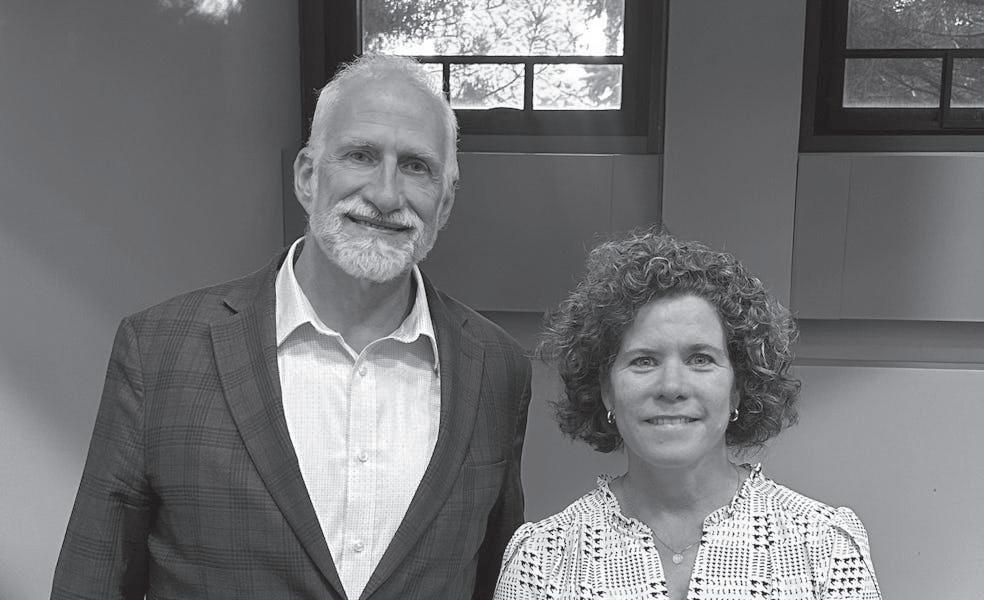
Architecture school recieves $150 million donation
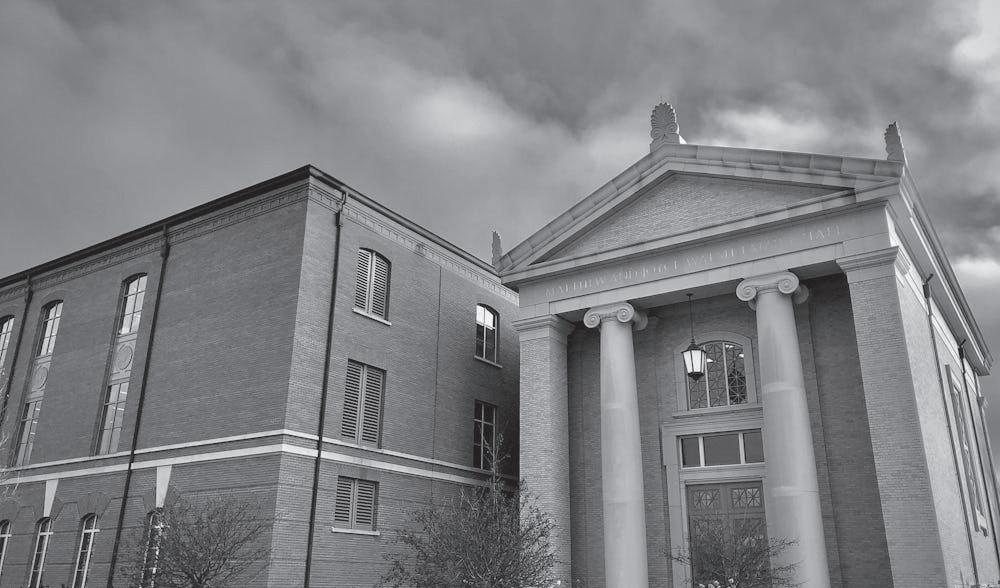
By Matthew Morin News Writer
Last week, the School of Architecture announced that it received a $150 million donation from Matthew and Joyce Walsh. Matthew
NEWS | PAGE 3
Korean film director
Acclaimed director Yim Soonrye visits ND for a screening of her film “Little Forest.”
OPINION | PAGE 6
Letter to the Editor
William Kurtz writes on how Notre Dames has failed sex abuse victims.
Walsh, a 1968 graduate from the University, chaired the School of Architecture Advisory Council from 2004 to 2021, according to a University press release.
With the couple’s donation, the school will be renamed the Matthew and Joyce Walsh
School of Architecture at Notre Dame.
The Walsh family has a long history with Notre Dame’s School of Architecture.
“Joyce and I were
page 4
Fr. Nate Wills releases book on ND football and faith
By Mara Hall News Writer
Fr. Nate Wills C.S.C. has served as the football chaplain for eight seasons. In his new book, “Pray Like a Champion Today: Sacred Stories from the Sidelines of Notre Dame Football,” he details his experience with the team and how it has shaped his faith.
Initially, Wills was surprised when Fr. Pete McCormick, C.S.C asked him to serve as the team’s chaplain. “I said, ‘First of all, I’m honored.’ And, second, I said, ‘I don’t know that much about football,’” Wills said.
McCormick assuaged Wills’ concerns. “[McCormick] said, ‘Nate, we pay a lot of people a lot of money to know everything
SCENE | PAGE 7
‘Vie’ Doja Cat goes retro Doja Cat’s return to pop is a successful throwback to the ‘80s.
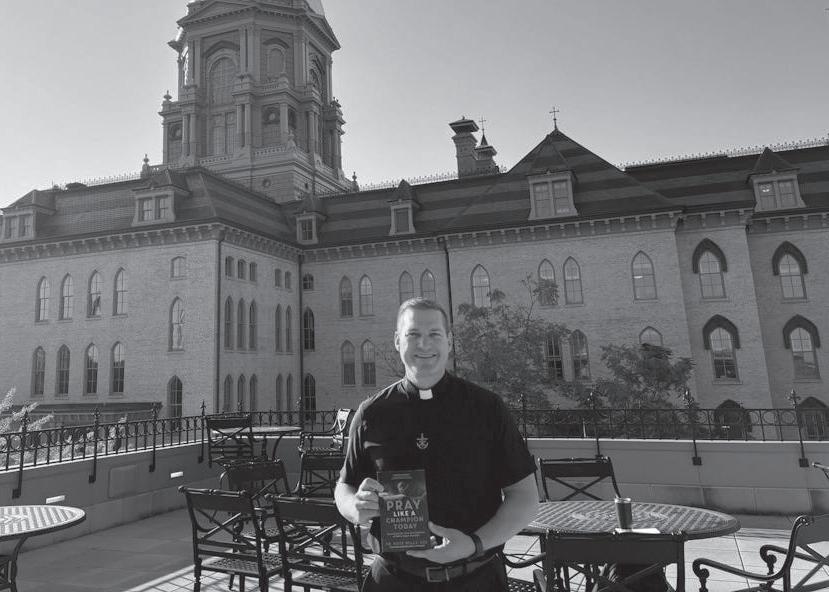
Fr. Nate Wills shares insights from his work as the Notre Dame football team’s chaplain in his new book, “Pray like a Champion Today.”
there is to know about football. We don’t need you to call plays. We just need you to point them to Jesus,’” Wills said. Wills has received
SPORTS | PAGE 10
Irish women’s golf
The Notre Dame women’s golf team achieved first place at the Women’s Fighting Irish Classic.
media attention for his work with a team, including an interview with ESPN Game Day in 2023. In the
SPORTS | PAGE 12
Irish men’s soccer
Thanks to a game-winning shot from a freshman, the Irish emerge victorious.

ndsmcobserver.com
“TO UNCOVER THE TRUTH AND REPORT IT ACCURATELY”
900 Hesburgh Library, Notre Dame, IN 46556
Editor-in-Chief
Liam Kelly
Managing Editor Gray Nocjar
Asst. Managing Editor: Aynslee Dellacca
Asst. Managing Editor: Grace Tadajweski
Asst. Managing Editor: Henry Jagodzinski
Notre Dame News Editor: Sophie Hanawalt
SMC News Editor: Berhan Hagezom
Opinion Editor: Redmond Bernhold
Sports Editor: Noah Cahill
Scene Editor: Peter Mikulski
Photo Editor: Mariella Taddonio
Graphics Editor: Isabelle Rutland
Social Media Editor: Duncan Stangel
Ad Design Manager: Isabelle Rutland
Business Manager: Zack Pohlman
Systems Administrator: Jack MapelLentz
Advertising advertising@ndsmcobserver.com
Editor-in-Chief lkelly8@nd.edu
Managing Editor gnocjar@nd.edu
Assistant Managing Editors adellacca01@saintmarys.edu, gtadajwe@nd.edu, hjagodzi@nd.edu
Business Manager zpohlma2@nd.edu
Notre Dame News Desk shanawal@nd.edu
Saint Mary’s News Desk bhagezom01@saintmarys.edu
Opinion Desk rbernho2@nd.edu
Sports Desk
ncahill2@nd.edu
Scene Desk
pmikulsk@nd.edu
Photo Desk mtaddonio01@saintmarys.edu
Systems & Web Administrators
webmaster@ndsmcobserver.com
Policies
The Observer is the independent, daily newspaper published in print and online by the students of the University of Notre Dame du Lac, Saint Mary’s College and Holy Cross College. Editorial content, including advertisements, is not governed by policies of the administration of any institution. The Observer reserves the right to refuse advertisements based on content.
The news is reported as accurately and objectively as possible. Unsigned editorials represent the opinion of the majority of the Editor-in-Chief, Managing Editor, Assistant Managing Editors and department editors. Commentaries, letters and columns present the views of the authors and not necessarily those of The Observer. Opinion space is available to all readers. The free expression of all opinions through letters is encouraged. Letters to the Editor must be signed and must include contact information.
Questions regarding Observer policies should be directed to Editor-in-Chief Liam Kelly.
Post Office Information
The Observer (USPS 599 2-4000) is published Monday through Friday except during exam and vacation periods.
A subscription to The Observer is $130 for one academic year; $75 for one semester. The Observer is published at 900 Hesburgh Library Notre Dame, IN 46556-0779 Periodical postage paid at Notre Dame and additional mailing offices
Today’s Staff
Corrections
The Observer regards itself as a professional publication and strives for the highest standards of journalism at all times. We do, however, recognize that we will make mistakes. If we have made a mistake, please contact us at editor@ ndsmcobserver.com so we can correct our error.
Architecture
Continued from page 1
introduced to the School of Architecture in 1996 by Andy McKenna Sr., then chairman of Notre Dame’s Board of Trustees,” Matthew Walsh said in press release. “Our now three-decade journey with the school, its deans, professors, students, and our Advisory Council peers has been transformational for both of us.”
Matthew Walsh hopes the gift will help further the mission of the aritecture program.
“Our goal in making this gift is to ensure that the Notre Dame School of Architecture continues to lead architecture across the world and the creation of world-class environments. Notre Dame architects have always been inspirational leaders. Our goal is to ensure that continues in perpetuity,“ he said in the press release.
Stefanos Polyzoides, the Francis and Kathleen Rooney dean of the School of Architecture, described this mission as a commitment to higher understanding and doing good.
“It’s a school of commitment to higher causes ... and better ways of understanding one’s discipline and profession and a greater commitment of improving the world,” he said. “That is a very, very key definition of what distinguishes the school, and perhaps something that the Walsh family might have been aware of when they gave us this gift … doing good in the world, it’s a daily thought that needs to be how we live.”
Polyzoides also voiced his appreciation for the Walsh family.
“They are very, very extraordinary human beings, and they’re profoundly important Catholics in the life of the
Accenture
Continued from page 1
perspective on the future of AI in various career industries.
Summers explained that technology prompting shifts in the workforce isn’t a new phenomenon. Jobs have evolved over time, but that doesn’t mean they are disappearing.
“Everyone’s worried that AI is going to take over all the jobs, but it’s not,” Summers said. She recommended everyone learn how to use AI, especially students. Citing a quote from Nvidia CEO Jensen Huang, Summers said, “AI is not going to take over your job. A person who uses AI is going to take over your job.”
Although she doesn’t believe AI will replace jobs completely, Summers explained that workplace roles are requiring greater knowledge of AI.
“Coding is not the only relevant skill … so whether it’s
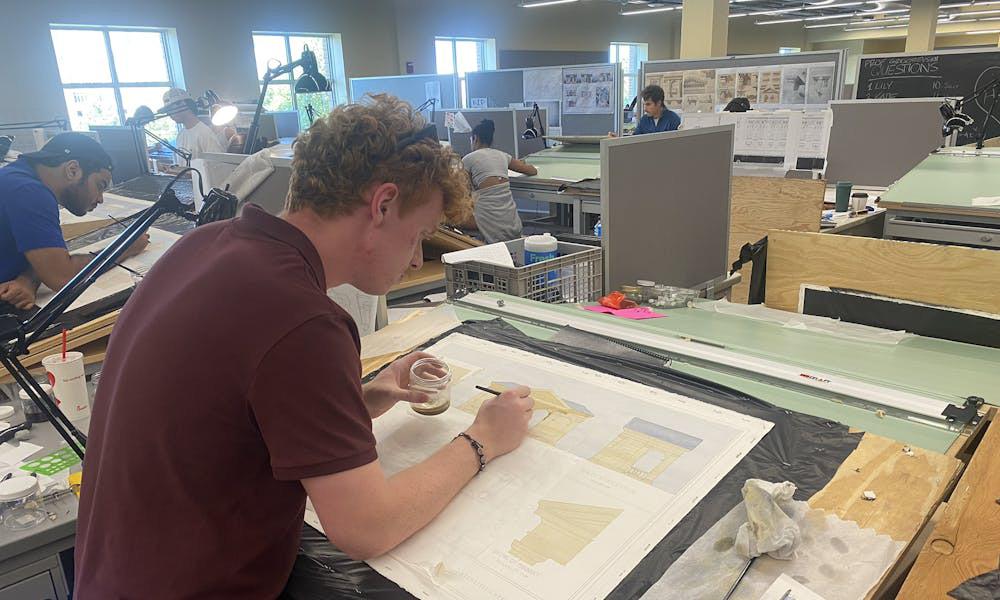
University and in the life of the community,” he said. “[They are] interested in art and architecture and how the world is made, and in Notre Dame terms, who uses the world and what ends, and how to make a just world through architectural building … We’re completely indebted to them. We admire them, we love them.”
The School of Architecture opened in 1994, after it was separated into an independent school, instead of being a department. The first architecture course was taught at the University in 1889.
Polyzoides described the school as having “a unique pedagogy which is not being followed by any other one of 135 schools of architecture in the United States.”
“We’re the only school in the country and in the world that has held the line for 35 years, going on 40, with a single evolving pedagogy and not depending on any one person,” he said.
Polyzoides noted that since the 1950s, other architectural schools have focused on modern building practices and individualism,
data literacy, … or tool fluency, or just understanding the job that you’re applying for or working in … There’s so much information, [and] there are foundational skills that need to be put in place in order for AI to really yield the efficiency and productivity different companies are expecting to see,” Summers said.
To keep up with the changing workforce, Summers gave students tips to effectively leverage skills. First, she encouraged students to experiment with using AI to increase productivity. She suggested focusing on AI-driven skills like prompting, critical thinking, experimentation, responsible use, and generative and agentic AI foundational training.
“I think it’s good for developing skills, but it’s also good for preparing people to adapt to a little bit more advanced AI,” Summers said.
John Behrens, a professor of Technology and Digital Studies at Notre Dame, explained the difference between generative AI
while Notre Dame has begun “to shift its curriculum away from fashion, self-expression, newness for newness’ sake towards its exact opposite … precedents, values, objectives, consequences and other things that people should worry about in their daily actions.”
The architecture curriculum will not change with this donation. Rather, the donation will “reinforce it and refine it and deepen it, and make it more effective in the world,” Polyzoides said.
Several years ago, during the For Good Campaign, the architecture program made requests for funding for a loan-free master’s program, a program in Preservation, Resilience, and Sustainability (for which they have since received a donation) and a Housing and Community Regeneration Initiative, which helps municipalities near Notre Dame to build and plan their city.
The school also requested funding for a program that involves “adaptive buildings and
and agentic AI. “Gen AI is kind of like the decision node, but the agentic AI is also going to include tools, orchestration, action and persistence like memory,” he said.
“So it’s more of an ecosystem in which gen AI is probably a part.”
Next, Summers discussed team-level optimization using AI. By creating foundational processes that incorporate AI, teams will increase productivity “and are able to free up extra time to work on other things,” Summers said.
Finally, Summers believes that applying AI to optimize revenues, reduce costs and drive innovation will create new cross functional ways of working. Companies are looking to blend AI with existing processes to speed up productivity. “The ability to cut something down into two weeks, for example, is really great,” she said.
Summers and Behrens described the permanent demand for the “six C’s” in the job force: creativity, critical thinking, communication, curiosity,
cities, which has to do with the scientific side or the technical side of one makes buildings that beautiful, adaptable and durable, as opposed to what’s going right now, [in] which buildings are ugly, temporary and inflexible,” Polyzoides said.
Finally, the school requested funding for the Mediterranean Studies Initiative, which would allow local faculty in Rome, “to both teach and research, outreaching to places around the Mediterranean basin, which are varied by culture, religion and otherwise, and helping people plan and build there,” Polyzoides said.
Polyzoides hopes that these programs, as well as new research opportunities, will be funded by the donation.
“We’re also trying to tie all of those activities with collegial enterprises and research throughout the University,” he said.
Contact Matthew Morin at mmorin2@nd.edu
compassion and collaboration. While the need for these human skills will be constant, Summers highlighted a few ways roles will evolve using AI, including drafting marketing content and developing strategic business recommendations.
Summers concluded her lecture by reminding students to stay curious, have a story to tell and be adaptable.
“I think Notre Dame students really have this always curious approach, and I think that’s really important [to be] open to opportunities once you get into a job … and start your career,” she said.
The Technology and Digital Studies program offers two additional lectures as a part of the “AI in the Liberal Arts” series. Lirio’s Kevin O’Brien will deliver his lecture on Oct. 15 and Imagine Learning’s Jason Fournier will speak on Nov. 19.
Contact Grace Sullivan at gsulli22@nd.edu.
Acclaimed Korean film director Yim Soon-rye visits ND
By Claire Lee News Writer
Last Thursday, the Debartolo Performing Arts Center screened the 2018 film “Little Forest” and hosted director Yim Soon-rye for a question and answer session. Yim also visited select film classes for intimate conversations. Film, television and theatre professor Cecilia Kim moderated the talk while a translator relayed Yim’s answers.
Yim is among South Korea’s most prominent female directors and a key figure in the country’s New Wave cinema. The screening was a rare opportunity for the University to host an acclaimed international filmmaker.
“Little Forest” follows a young woman, Hye-won, played by Korean actress Kim Tae-ri, who leaves behind her urban lifestyle for one of farming in the countryside. Through farming and cooking, Hye-won heals her inner conflicts and rediscovers comfort in a simple life.
Yim communicated that her goal in making the film was not to convince young people that a rural life was the answer to urban struggles, but rather encourage them to consider alternative ways of living. She hopes young people reflect on their true needs and values, resolving internal conflicts through a deep connection with and appreciation of the natural world.
“I want the young people [of Korea] to think about ... what they really need, what they really want and really get in touch [with] their inner selves to find out,” Yim said.
Yim noted that she was surprised by the film’s
Book
Continued from page 1
interview, Wills discussed prayer medals — small silver tokens with images of saints that players receive at team Mass before kickoff.
“[Prayer medals] are a more than 100-year tradition at Notre Dame, but it was really fun to be able to share that with people outside of Notre Dame. To say, you know, here are the good things that are happening at Notre Dame and to show them that there are all these paths to holiness,” Wills said.
While maintaining the longtime tradition, Wills has made a few tweaks to broaden the reach and representation of the saints featured on the medals.
success among foreign audiences. When she adapted the Japanese original, she only considered how it would resonate with a Korean audience. She credits the success of the film to its overarching message, especially among her younger audience.
“I wanted to tell the young audience in Korea that there is an alternative life. You know, you don’t always have to leave. You don’t [always] have to be in overdrive and ... in competition, but take it easy and slow down,” Yim said. “I think that message really resonated with my young audience.”
Yim’s visit was coordinated by Kim, who teaches a course on East Asian cinema. According to Kim, she hoped the event would draw attention to underrepresented voices in cinema and broaden Notre Dame’s appreciation of Asian culture through art and entertainment.
Kim’s course covers the cinema of East Asia, which she admits is quite a large geographical region for one semester. Kim noted she carefully samples films that would provide valuable access points for students to explore further. In addition, she selects films that situate cinema within the countries’ political and social contexts.
“I select the films based on the relationship between the film and its kind of political, socio cultural context, and give [the students] the context of how this film was made, and also why it’s significant for us to look at it from this kind of like Western educational standpoint,” Kim said.
According to Kim, class discussions highlight
“I thought it might be nice to get some more modern saints in there. For one of our bowl games, I ordered St. Josephine Bakhita, who is a great African saint, to try to just increase some diversity there,” Wills said.
He also started an Instagram page in 2020, @ PrayLikeAChampionToday, where he shares the saint of the week by posting a picture of a player with the medal. “[It is] not just about the saint, but to have one of the players hold the medal as well, and to kind of honor them,” Wills said.
The title of the book was inspired by the Instagram page. “I suggested the title ‘Pray Like a Champion Today, Sacred Stories from the Sidelines of Notre Dame Football,’ and [the publisher]
assumptions foreign audiences may make on aspects of a film such as narrative and character representation, and how “to realize the differences of the kind of assumptions that we make on the narrative, or the assumptions that we make on character representation,” Kim said.
Kim was motivated to feature “Little Forest” and invite Yim to Notre Dame when she and her previous students realized her course syllabus lacked the works of female directors. Kim noted that her syllabus reflected the broader underrepresentation of women in the film industry.
“[Yim] is one of the sofew female directors at her time, there were no female directors in the industry six years before she went in and four more years after she was there. So like, close to 10 years that she was in the industry, there were no other women,” Kim said.
In her course, Kim also aimed to share a culture of slow-cinema, which is commonly appreciated and studied in Asia and contrasts with the action-packed and narrativedriven nature of Western Hollywood cinema. Kim first reached out to Yim almost two years ago and noted that it was initially “tricky” to contact the prominent figure and arrange the visit in between her busy filming schedule.
Recounting the process, Kim said “given that I didn’t have any personal connections with the director, she was really open to the idea of visiting campus.”
Due to the smaller size of Kim’s class on East Asian cinema, students were able to share intimate discourse
said, ‘Look, we never take the titles that the writers give us, but we actually like this one,’” Wills said.
On the football team, Wills interacts with people from a variety of faith backgrounds. In navigating denominational differences, he said he likes to lead by listening. As well as diversifying the saints represented in prayer medals, he shared that he added some who are more scripturebased, as those often resonate more with Protestant teammates.
Additionally, Wills aims to be an open resource for players to ask questions about the Catholic faith.
“I also really enjoy talking about the Mass and why we do what we do in the Mass. Sometimes, I will
with the director over lunch and in their class. Leah Rose Benny, a senior business analytics and film, television and theatre major, noted that she and her classmates were eager to engage with Yim despite language differences.
When asked why she believed the film was so successful among global foreign audiences, Benny highlighted the film’s theme of burnout, and how “despite cultural barriers, [the film] resonates with a lot of people, especially in today’s fast-paced world.”
Benny also noted how the process of making and enjoying food, which was demonstrated in “Little Forest,” can transcend tradition and taste, connecting people of different backgrounds.
“I feel like [food] is something that automatically connects people ... being able to see her make these delicious meals, and be able to see her eat them so deliciously, you feel connected to the protagonist in that way,” Benny said.
Kim added that she believed the director to be “very humorous” and expressed slight regret that Yim’s amusing demeanor may be lost in translation. Similarly, Kim noted how some of the linguistic and cultural nuances, such as jokes and dish names, were misrepresented in the subtitles of the film, something Yim said she had no control over.
“I think they could have just maybe used the [original] names [of the dishes], but instead they were kind of translated to easily digestible Western explanations ... I think that was maybe unnecessary,” Kim said. “Because what if someone
point out when there is a particular saint that resonates in the space where we are … often the Basilica is just a beautiful encyclopedia of our faith and the saints,” Wills said.
Due to his role as chaplain, Wills sits at a unique position to see the role of the church and the University intersecting through sports.
“I think Notre Dame has a really great opportunity to witness to the world how many different parts of our lives can be integrated in a really beautiful way that we are complete people that bring everything who we are to the world,” Wills said. “So our student athletes are not just athletes, they are student athletes, and I think Notre Dame is a great example of a university
watched a film, and they went to Korea, and they wanted to try it out, then you [wouldn’t] know what it’s called.”
During the question and answer session, many audience members praised the deliberately paced film and expressed discontentment with recent industry trends of commercial cinema. Audience members also found the featured dishes of the film appetizing and enjoyed the film’s absence of technology.
Senior psychology and sociology major Sandy Kang, who attended the screening for leisure, was impressed with how seamlessly the director adjusted highly specific social and emotional elements from the original adaptation to account for distinct cultural differences between Japan and Korea, with Kang being Korean American herself.
“I didn’t know that one small decision would make such a big difference,” Kang said, referring to an adjusted dynamic between two characters. “I never really thought about how much the emotional [effect] would linger throughout the film.”
Although she acknowledges students’ busy schedules, Kim hopes that students can set aside time to watch films that demonstrate new perspectives and cultures.
“Films require so much care and labor,” Kim said. “Whatever it is, there’s always something to learn from a film that you might not be able to learn in your everyday life.”
Contact Claire Lee at clee35@nd.edu
that says we will not sacrifice your education because we want you to play a sport. We want to bring those things together in student athlete’s lives.”
Prior to his book, Wills had writing experience from his dissertation and preparing for homilies. He described the chapters as extended homilies with a story, a biblical connection and a call to action.
Mills said that his book came together quickly between October and February, after he had been thinking about his experiences while preparing for a segment for the Alumni Association’s Sacred Stories for Advent collection.
Contact Mara Hall at mhall27@nd.edu
Free speech
Continued from page 1
Student Voices for Palestine (SVP) James Thompson offered his perspective on selfcensorship, saying that “there is an overall baseline of what is acceptable to talk about at Notre Dame and in what way, but there are a lot of really great people who see the potential for the University to pursue serious dialogue on campus.”
Despite some self-censorship, College Republicans president Shri Thakur believes the environment at Notre Dame is more conducive to free speech than that of other universities.
“I know many of my peers have felt the need to self-censor to some extent. But I think overall the environment at Notre Dame for free speech is better within the bounds of a Catholic university and the Catholic character,” he said.
Thakur made note that while other colleges and universities may be likely to censor conservative voices, he sees Notre Dame’s low grade as an effect of its Catholic institutional values, which may discourage certain topics like abortion from being discussed or endorsed by faculty or students.
Senior Alex Young, co-president of College Democrats, agreed that Notre Dame’s Catholic identity allows the University to set parameters surrounding student speech.
The report attributed part of this drop in ranking to the cancellation of University of Chicago professor Eman Abdelhadi’s planned keynote address at the Kroc Institute’s student peace conference last April. FIRE labeled this incident as the University’s only “speech controversy,” and it is the first that FIRE has flagged at Notre Dame since it began its rankings in 2021.
Abdelhadi was set to speak about pro-Palestine organizing on college campuses at the conference when the conference’s student organizers received an email six days before the event informing them that University administrators decided to rescind her invitation, citing their inability to provide increased security at the event, which was required at events discussing Israel and Palestine, as reason for the cancellation with the combination of a short notice of the topic of her address, the Blue-Gold football scrimmage and Holy Half Marathon happening on campus that same day.
“To be able to have constructive conversations is a pillar of academic expression, so the fact that they would say no, there needs to be security and we can’t provide security so we’re just not going to have it, was indicative of a deeper issue of academic censorship existing in this current trend in this country,” student organizer Eva Garces-Foley told The Observer in April.
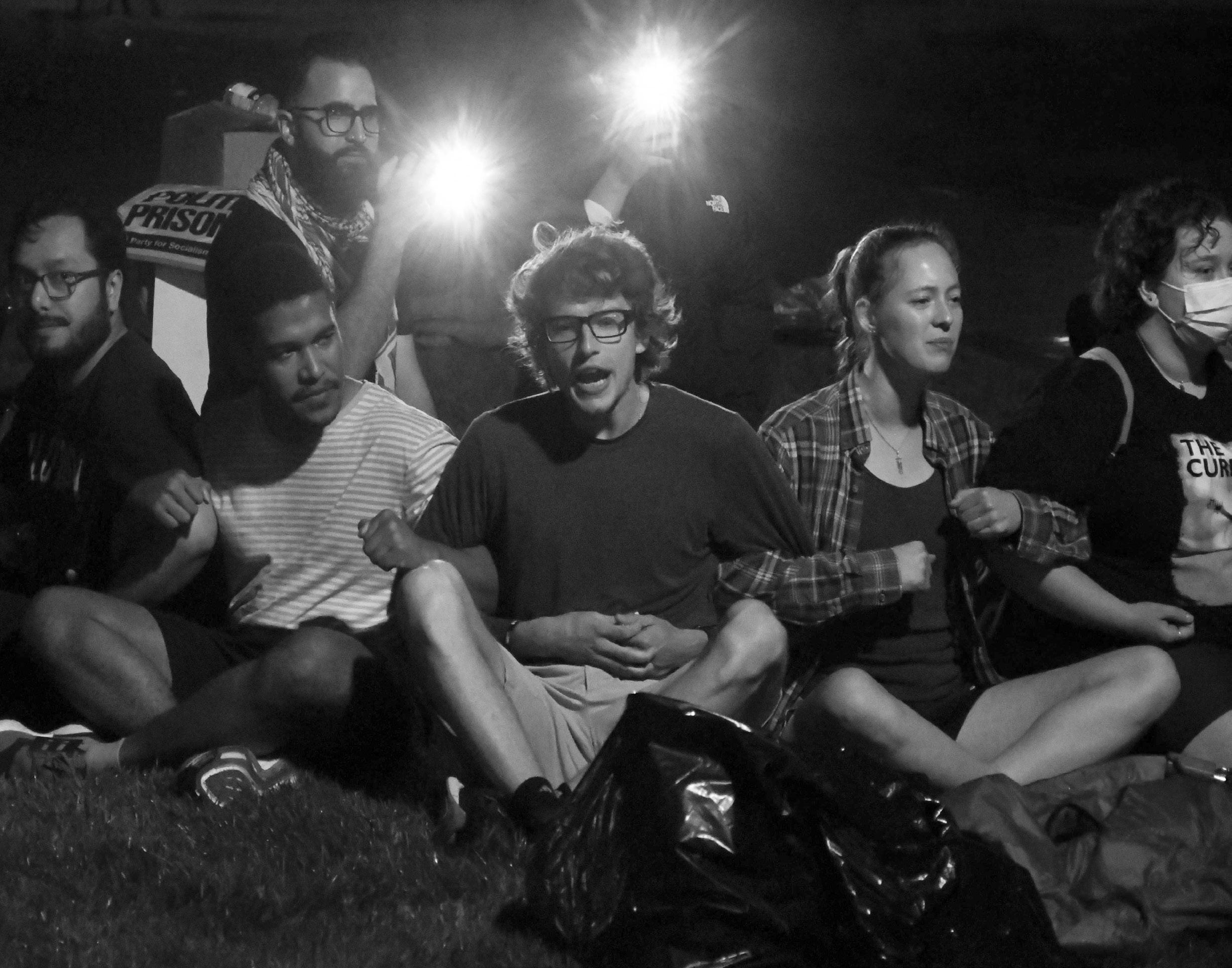
Abdelhadi spoke out against her disinvitation in an op-ed, and students and faculty at Notre Dame’s Kroc Institute signed onto a letter condemning her disinvitation and alleging that the University was violating academic freedom.
Notre Dame placed in the top 50 for disruptive conduct. 69% of students agreed that “shouting down a speaker to prevent them from speaking on campus is acceptable, at least in rare cases,” compared to 72% of overall students agreeing.
24% of Notre Dame students surveyed agreed that “using violence to stop someone from speaking on campus is acceptable, at least in rare cases,” lower than the overall 34% of student respondents who agreed with that statement.
In response to the FIRE ranking, University spokesperson Erin Blasko wrote in a statement to The Observer, “The University of Notre Dame has an unwavering commitment to academic freedom and freedom of expression. These principles are and must be foundational to our life as a community of scholars. Speech that incites violence, involves threats, or constitutes harassment will not be tolerated.”
Blasko continued, “In addition, compliance with Notre Dame’s policy regarding the time, manner, and place for free expression is essential so that the work of the University—the teaching, learning, research, and intellectual exchange core to our mission—can continue even as we grapple with important issues. At Notre Dame, we seek to be a model of vigorous
but respectful dialogue for a society greatly in need.”
Free speech has been particularly at the forefront of campus and nationwide discourse since the shooting of Charlie Kirk, a conservative political activist, while he spoke on Utah Valley University’s campus on Sept. 10.
In an email to the Notre Dame community on Sept. 12, University President Fr. Robert Dowd encouraged, in light of recent violence in educational settings and a rise in political violence, community members to recommit themselves to being part of the solution.
“Let us recommit to listening to those with different viewpoints and to engaging in respectful dialogue. We are diminished as individuals and as a community if we engage only with the like-minded, and most especially, if we fail to treat with respect those with whom we disagree,” Dowd wrote.
Notre Dame’s du Lac student life policies detail the University’s policy on demonstration. Students are expected to adhere to location, time and manner restrictions, which the University writes are designed to “(a) protect the health and safety of participants and the campus community, (b) avoid disruption of the regular and essential operations of the University, and (c) maintain an atmosphere conducive to scholarly and educational pursuits. In addition, all demonstrations must be registered in advance and in writing with the Vice President for University Operations, Events, and Safety or designee,” the policy reads.
Young expressed concern about what he called, “Notre Dame’s stricter rules about protesting,” which forbid student groups from encouraging activities that contradict the University’s values, and regarding student groups not being able to discuss abortion and reproductive healthcare.
Notre Dame received praise from former President Richard Nixon for a policy enacted by former University President Fr. Theodore M. Hesburgh pertaining to protests during the Vietnam War, which mandated that student protestors be given 15 minutes to protest before having to cease and desist.
Thompson critiqued the 15-minute rule, which he believes restricts student expression.
“I do think the 15-minute rule, especially, is a Vietnam War Era tactic from the University to shut down any sort of student expression, and so that is definitely a structural issue. There is also no clear definition of what a demonstration is on campus. So it leads certain offices to be able to decide what is or is not a demonstration and thus subject us to different approval processes,” Thompson said.
Connor Marrott, who graduated last year and was one of 17 demonstrators apprehended on May 2, 2024 during a proPalestine protest, echoed this criticism.
“What I do not think a lot of people realize is that the 15-minute rule has been applied to both conservatives and republican radical organizers on campus, and has resulted in the arrest of
students across the ideological spectrum,” he said.
Marrott believes that the University arrested students not because of their behavior but because of the content of their protest.
“The issue with that is, we took from that same model as the anti-drag protests, because the University let that happen, letting students pray outside of an academic building, outside of an academic event. The University did not arrest them, but when we do that against genocide, which is an issue that our political leaders have vilified, we are met with more limitations and repressions,” he said.
Although Thompson was critical of the University’s handling of the pro-Palestine protest, Thompson still believes the University’s “F” ranking to be harsh.
“I think an ‘F’ is a little extreme, because there is not an insane amount of oppression, despite arresting our students last year and pursuing them in court for speaking their mind about Palestine. However, I do think that the University’s primary function is to facilitate dialogue, and I believe that there are wonderful students, organizers, academics and activists who make this a better place for dialogue,” Thompson said.
Editor’s note: Marrott is a former opinion columnist for The Observer.
Contact Sophie Hanawalt at shanawal@nd.edu and Zander Daigle at zdaigle@nd.edu
Belonging, memory and the new face of ND
By Molly Wu Columnist, “Bro Meets World”
When Notre Dame announced that it was changing its football leprechaun logo for the first time in more than 60 years, I was surprised by how strongly I reacted. As an international student, unlike many of my peers, I did not grow up watching college football or tracing the program’s traditions. The leprechaun, for me, was not something inherited through childhood memories of Saturday games. And yet when I saw the redesigned logo — sleeker, more modern, the leprechaun now sprinting forward with a football — I felt struck. I realized how quickly a symbol can weave itself into your sense of belonging, even if you enter from the outside.
The old logo showed a leprechaun in a fighting stance, fists raised, defiant and stubborn. The new version depicts him midstride, charging downfield. To some, this shift might seem cosmetic. But I believe for Notre Dame students, alumni and fans, the logo is not simply an image. It is a piece of collective identity. In the dining hall, on sweatshirts or emblazoned across helmets, the leprechaun represents a community and a story. Even for someone like me, who does not have decades of family tradition tied to Notre Dame football, it carries a weight that is difficult to ignore, to my surprise. Growing
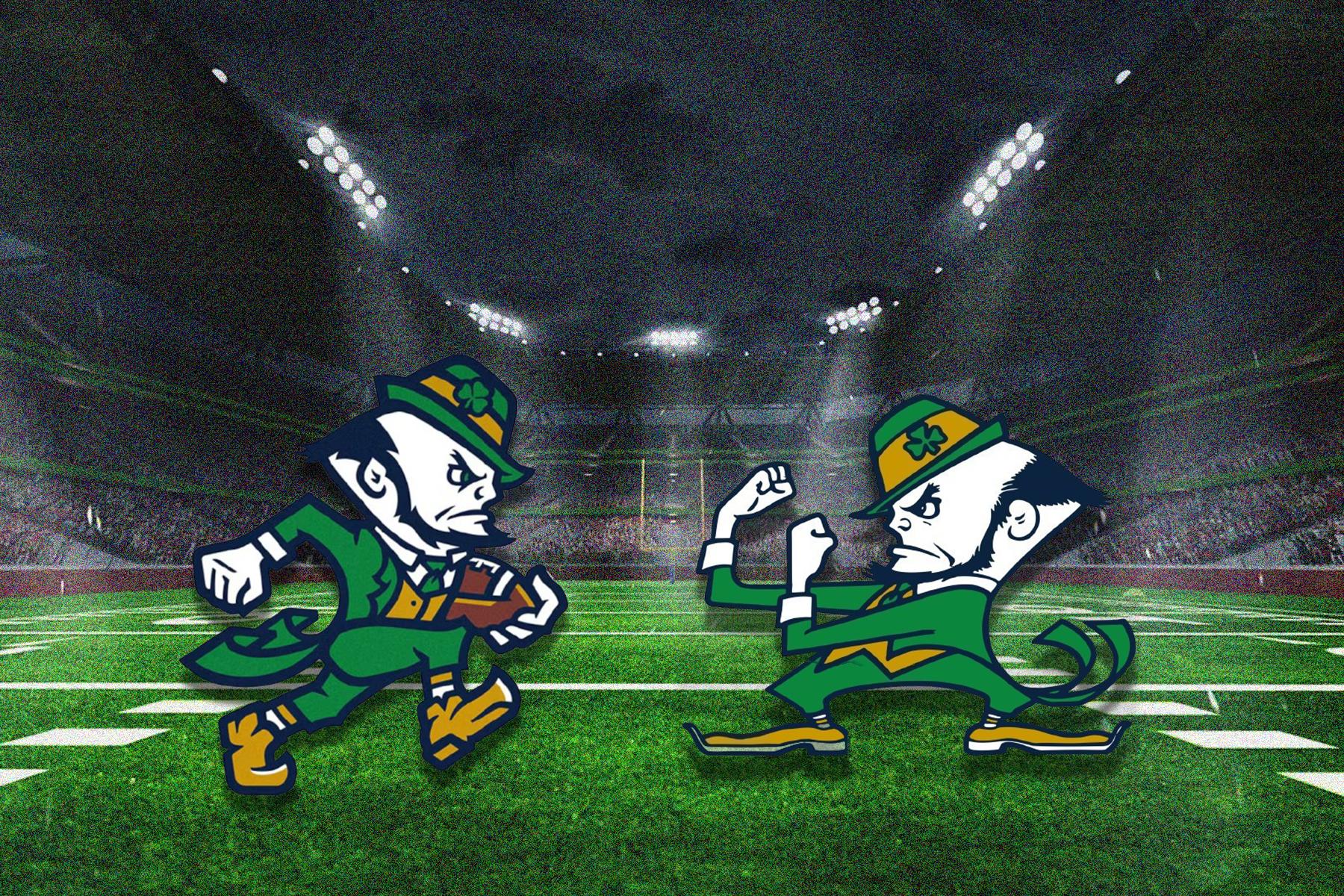
up playing competitive golf, I once again reflect on the power of sports. It is extremely difficult for me to think of any other arenas that can take a logo and turn it into a vessel for such intense, complicated emotion. In elementary school, when I first came to the states to compete in state and national tournaments, though not at all fluent in English, I was able to make friends on the golf course. Golf has also become a bridge between me and my family, creating so many cherishable memories that would not have been possible without it. Sports bind people across generations. Moving from the personal to the broader perspective, sports give communities common
rituals, language and heroes. Participating in tailgates and celebrating a Notre Dame win have brought me friendships, memories and a newfound identity. When Notre Dame changes its football logo, it feels like more than a marketing decision; it feels like a rewriting of memory. For alumni, the old logo may carry the echo of Lou Holtz’s championship years or a first game with their parents. For students like me, it marks a signal that we belong to something larger than ourselves. That is why sports are so politically and culturally powerful. They create shared myths and symbols that are as potent as national flags or anthems.
A touchdown in Notre Dame
Stadium may not seem political, but the feelings it generates — pride, unity, defiance — are the same emotions nations rely on to bind citizens together.
As an international student, I sometimes view American football from the outside, trying to understand its rituals and language. But I cannot deny its ability to arouse emotions that transcend knowledge of the game. When the band plays, when the crowd celebrates, when the logo flashes across the screen, you feel pulled into something collective. That feeling of being absorbed into a larger story may be the deepest power of sports. And it explains why even a logo can matter so much.
The revival of debate
By Sophia
The American debate has disappeared. We have gradually witnessed the devolution of what used to be a respectful tradition of political discourse into a melee of personal attacks that veer far from actual policy. Debate functions as a platform for candidates to make crystal clear where they stand on issues and how they will make Americans’ lives easier – that has been obscured in recent years. The 2024 Trump-Biden presidential debate is a striking example of what debate has become: a catfight akin to an episode of “The Jersey Shore” and a slew of meme bits.
Political conflict is not inherently bad. Through forcing both sides of an issue to articulate their arguments and refine their reasoning, conflict is healthy for democracy. In the same vein, competition is not inherently bad. We’ve reached the heights of economic and societal prosperity because our systems channel self-interest into the promotion of the common good. Conflict, competition
and disagreement are cornerstones of any operational democracy. They lead to innovative policies and crucial problem-solving by pushing us to confront the realities of our beliefs. And it is on the debate stage where these democratic pillars manifest themselves most poignantly.
Though what is beautiful about true debate is that it resolves this conflict not inherently by promoting each side’s desire to win. Rather, the common goal that dominates here is an understanding of a way forward. Presidential debates make this principle most clear. When the welfare of the public is at stake, when millions of average Americans are directly affected by either policy direction, the candidates win only by playing into this emphasis.
But most of us will never see the blinding lights of a presidential debate stage, much less involve ourselves in a political career. Yet, the ability to coherently present an informed argument in a competitive, pressurized environment is a skill we will all find ourselves needing to hone at one point or another. Whether
during negotiations between parties in a major merger deal or on the congressional floor at the U.S. Capitol, we will inevitably encounter the infamous debate stage.
So how do we become better debaters? I’d like to suggest a revival of the debate. We didn’t come to Notre Dame to shy away from real issues by playing it safe. Sure, it may be easy to simply engage in dialogue and leave it there out of fear that a step further would invite hatred. But we came to Notre Dame to do hard things, to take that extra step and do what presidential candidates seemingly aren’t able to. We came to learn how to wrestle with difficult topics so that when it matters in the real world, we’re able to change the status quo. We came to reorient the conversation and the debate in this case toward the common good. Dialogue is a fantastic starting point, but it is by wrestling with the nuances of the ideologies we stand beside, by facing the counterarguments posed by our adversaries head-on, that we truly become better citizens.
The beauty of true debate is
This is why sports, and especially college sports, are uniquely powerful. They bridge the gap between personal and collective identity. They transform a logo into a memory and a memory into a tradition. And when that tradition shifts, even slightly, it reverberates across the community.
Of course, I see the other side. Universities must evolve. The world of college athletics is changing with conference realignment, NIL deals and relentless media scrutiny. Branding matters in recruiting and projecting an image of energy and modernity. The new leprechaun looks faster, bolder, more aligned with the dynamism Notre Dame wants to display. In the end, I do not know if the new leprechaun will come to feel natural, or if I will always instinctively prefer the old one. What I do know is that this moment has taught me something about the politics of symbols. They matter not because of their design, but because of the emotions and stories we invest in them. And while the logo may change, I am hopeful that the memories it carries will endure, never washed away by a new design.
The views expressed in this column are those of the author and not necessarily those of The Observer.
Contact Molly Wu at lwu5@nd.edu
blurred by the notion of winning. As we increasingly hyperfixate on collecting points and knocking our opponents off their feet, we lose sight of its purpose as rooted in finding a way toward the common good. We spend too much time talking about what we are, when what’s far more important is who we are. Just like you can agree and still be a bad person, you can disagree and still be a good person.
The people behind the policies get lost in the contemporary debate because we fail to lead with our values. When we learn to acknowledge the humanity of our opponents, it becomes exponentially more difficult to lob personal attacks and spew hate-based rhetoric.
When we successfully debate when it really matters, we hold the power to solve political conflict in the way our founders intended. We safeguard democracy by proving that it’s possible to present informed arguments in order to create a more informed public. When we are unable to do so, what option is left but coercion? If we fail to have the hard conversations, where
does that leave us but a nation that normalizes the easy way out?
The revival of the debate is no easy feat. We have all the reasons to fear a stage that has, in recent years, been the subject of great controversy. But shying away from facing conflict achieves nothing. The only way we can return to a standard of respect is by developing that skill and exercising our muscles to compete cordially. In reviving the debate as a proper channel of respectful competition, we would do well to jump in headfirst. We all dread spinach, but it really is healthy for us. Join BridgeND on Oct. 8 at 6:30 p.m. in Dahnke Ballroom for our capstone event: ConvergeND. In the spirit of revival, we will be hosting a debate between the very best of College Republicans and College Democrats.
The views expressed in this column are those of the author and not necessarily those of The Observer.
Contact Sophia Combs at scombs3@nd.edu
By Sophia Anderson Columnist, “Transfer Tales”
It’s time to rethink networking
When people ask me what I’m doing this semester, I always compare Notre Dame’s Washington, D.C. program to studying abroad. It really is similar (Disclaimer: I actually haven’t studied abroad, but I imagine it’s similar.).
We take classes with local professors, many of which teach on D.C.; we spend our weekends exploring the city and we live in regular apartments rather than dorms. One key difference, however, is that students in our program work internships during the weekdays. Working a professional internship has come with a steep learning curve. I had to expand my corporate wardrobe, get accustomed to the 9 a.m. to 5 p.m. schedule and (most jarringly) learn to “network.”
Networking, or according to Merriam-Webster, “the cultivation of productive relationships for employment or business,” has been on my mind since before I even came to the city. As I get older, and life after undergrad looms (I’m only a junior, but still.), I have felt the growing pressure to get networking. I have no doubt: It’s officially time to start working that infamous Notre Dame network. While I obviously recognize the value and importance of networking, I have always struggled a bit with the concept as I’ve always imagined it. To me, networking has meant going to random networking
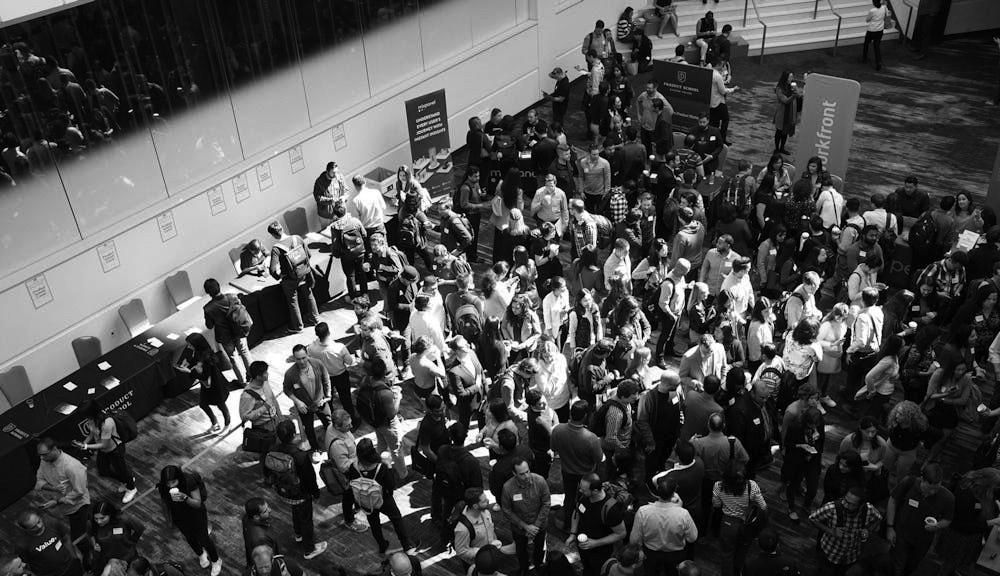
“events,” trying to get meetings or calls with established professionals (who I have little to offer in return as a college intern) and cold messaging LinkedIn connections with Notre Dame listed in their bios. I think my hesitation to dive in headfirst is understandable; this version of networking feels overly transactional, awkward and sometimes even slimy.
I had resigned myself to trying to push past these feelings and attempt networking to the best of my ability. While discussing my feelings with some friends, however, I received some advice that has helped me completely reframe the idea of networking in my mind. It’s not about exchanging emails or maintaining as many vague
acquaintances as possible; it’s about building actual, strong, lasting relationships.
The first aspect of relationship-centered networking is only doing it with people you’re genuinely interested in knowing (in a non-transactional way). For example, imagine this choice: You could introduce yourself to someone who works for a large company that you would consider applying to a few years in the future. You would probably have a superficial but feel-good meeting, exchange emails and forget you ever met; for all you know, they’ll have left the company by the time you’re ready to apply.
Alternatively, you can get coffee with a 2025 ND grad that you had a couple classes
LETTER TO THE EDITOR
with and whose work you genuinely admire. Even if their work isn’t your exact career interest, you will bond over your existing connection, and they will remember that you wanted to reconnect and hear about their career. A few years down the line, you could still be in touch, and they might offer you valuable advice or even connect you with a job opportunity. I may have written the question in a slightly biased way, but my point still stands: I would choose to develop an existing friendship every time.
Besides prioritizing people I’m more likely to build a real friendship with, I think the best form of networking is my regular daily interactions. Every time I make a new friend
on campus or make small talk with my coworker, I’m building a connection I can rely on long term. The people I trust to care about my personal life and help me with personal issues are the same people I would most trust to help me professionally.
It’s also w to be open to “network” (read: become friends) with people outside my field. All my close friends don’t need to, and shouldn’t, be political science majors. I believe a diverse list of connections, with different majors, skills, friends and career industries, is far more beneficial than a superficial list of people you hope to call and subtly beg for a job one day. A friend who becomes a doctor or an engineer might help me in an unexpected way 20 years from now; they could give me an edge over other, regular networkers. The most important thing I’ll be keeping in mind as I begin to network is sincerity. I don’t plan on forcing connections with anyone I’m not genuinely interested in knowing (while still keeping an open mind about meeting anyone). At the end of the day, I believe organic, earnest and diverse friendships will serve me more than shallow networking ever will.
The views expressed in this column are those of the author and not necessarily those of The Observer.
Contact Sophia Anderson at sander38@nd.edu
Notre Dame has failed sex abuse victims
Dear President Dowd and Members of the Board of Trustees,
I am writing in response to the University’s recent statement regarding the allegations of sexual misconduct against former Zahm Hall rector, Rev. Thomas King, C.S.C., who served from 1980 to 1997. While the decision to convene a special committee and launch an external investigation is a necessary first step, the language and posture of the University’s public statement fail to meet Notre Dame’s high standards of always doing “the right thing.”
I write not only as an alumnus but as a victim of sexual abuse that occurred my sophomore year at Notre Dame. This personal experience has made me an advocate for other survivors of abuse in the Catholic Church. As a victim and advocate, I believe that how Notre Dame mishandled King’s abuse of students is part of an institutional pattern of placing Notre Dame’s
reputation above support of victims. One need only look at how the University merely apologized but did nothing else to help former student Mark Fuller (class of 1977) who was raped by the then rector of St. Edward’s Hall, the University’s refusal in 2018 to immediately revoke the honorary degree of serial child abuser Cardinal Theodore McCarrick or how it badly mishandled the tragic suicide of Saint Mary’s student Lizzy Seeberg, who died after she was sexually abused by a football player in 2010, to see this pattern quite clearly. President Dowd’s statement demonstrates that the University has yet to fully internalize the necessary lessons from its own history and the wider sex abuse crisis facing the Catholic world.
My primary concern with the University’s statement centers on how it repeatedly frames the victims’ experiences with terms of doubt, stating that some community
members “may have suffered abuse” and referring to the events as “alleged conduct.”
Frankly, this cautious, legalistic language is horribly outdated, and it echoes the strategies of denial employed by Catholic authorities before the 2002 Boston Globe revelations of widespread abuse in Boston, made infamous by the award-winning movie “Spotlight.”
Multiple victims of King have come forward already, with one Notre Dame alumnus alleging that the University “knew about the abuse as early as 1995/96.” If true, this raises the important question of why didn’t Notre Dame deal forthrightly with the University community in 1997 instead of allowing King to “retire” from his role as rector? Or, for that matter, why was King allowed to continue in other ministries after allegations against him were brought forward?
Unfortunately, such was the larger pattern of the global Catholic Church, which was
to shift abusive priests quietly from one assignment to another.
Furthermore, I take issue with the statement that, “Our hope is that this external investigation will provide those who may have been affected with the opportunity to be heard.” The opportunity “to be heard” is the bare minimum requirement for any investigation and is woefully insufficient given the gravity of the crimes committed. Victims do not need the University to grant them a platform to speak; they need the University to provide accountability, justice and compensation.
They, and the rest of the Notre Dame community, deserve a full, transparent report (similar to the Vatican’s McCarrick Report) of what went wrong, not just “the key findings.”
Real support for the students victimized by Father King involves a commitment to action beyond simply receiving
testimony. It requires:
1. A clear statement that the University failed in its most important duty — ensuring the well-being of its students — during King’s tenure.
2. A commitment to understanding and disclosing how past abuse complaints were handled and why institutional systems failed to prevent serial abuse and, in King’s case, may have kept it under wraps for decades.
3. Implementing systemic safeguards that are both proactive and transparent. The University needs a complete paradigm shift in how it handles sexual abuse allegations on campus.
4. Doing justice to victims by appropriately compensating them for both the horrible pain caused by Father King as well as Notre Dame’s institutional failures to protect them.
‘One Battle After Another’ meets our current moment
By Luke Foley Scene Copy Editor
It’s been an exhausting year. Our country has descended into a funhouse of horrors where things are as stupid as they are evil. It feels like most people have been in a daze, unsure how to process the colossal dismantling of everything. Enter Paul Thomas Anderson (PTA), the wunderkind auteur with one of the most beloved filmographies in all of cinema. His films span so many different moods, periods and genres; the only consistent trait is that they’re all bangers. PTA’s last film, “Licorice Pizza,” was a nostalgic ode to age gap relationships and sleazy entrepreneurship. His latest film, “One Battle After Another,” was released in theaters this past weekend. There’s been a lot of excitement and curiosity surrounding this one; its staggeringly high budget of around $150 million had many scratching their heads as to why Warner Bros. would throw so much money at an arthouse director, and rumors that it was an adaptation of Thomas Pynchon’s “Vineland” intrigued the literature world. But the film lives up to its hype and then some. “One Battle After Another” rattles with urgency and vitality, tapping into the current moment and shattering our despondency with some masterful filmmaking.
“One Battle After Another” is probably one of the most overtly political blockbusters in recent memory; there is no subtlety to be found here. The film’s plot revolves around the political revolutionary group, the French 75, fighting the U.S. government,
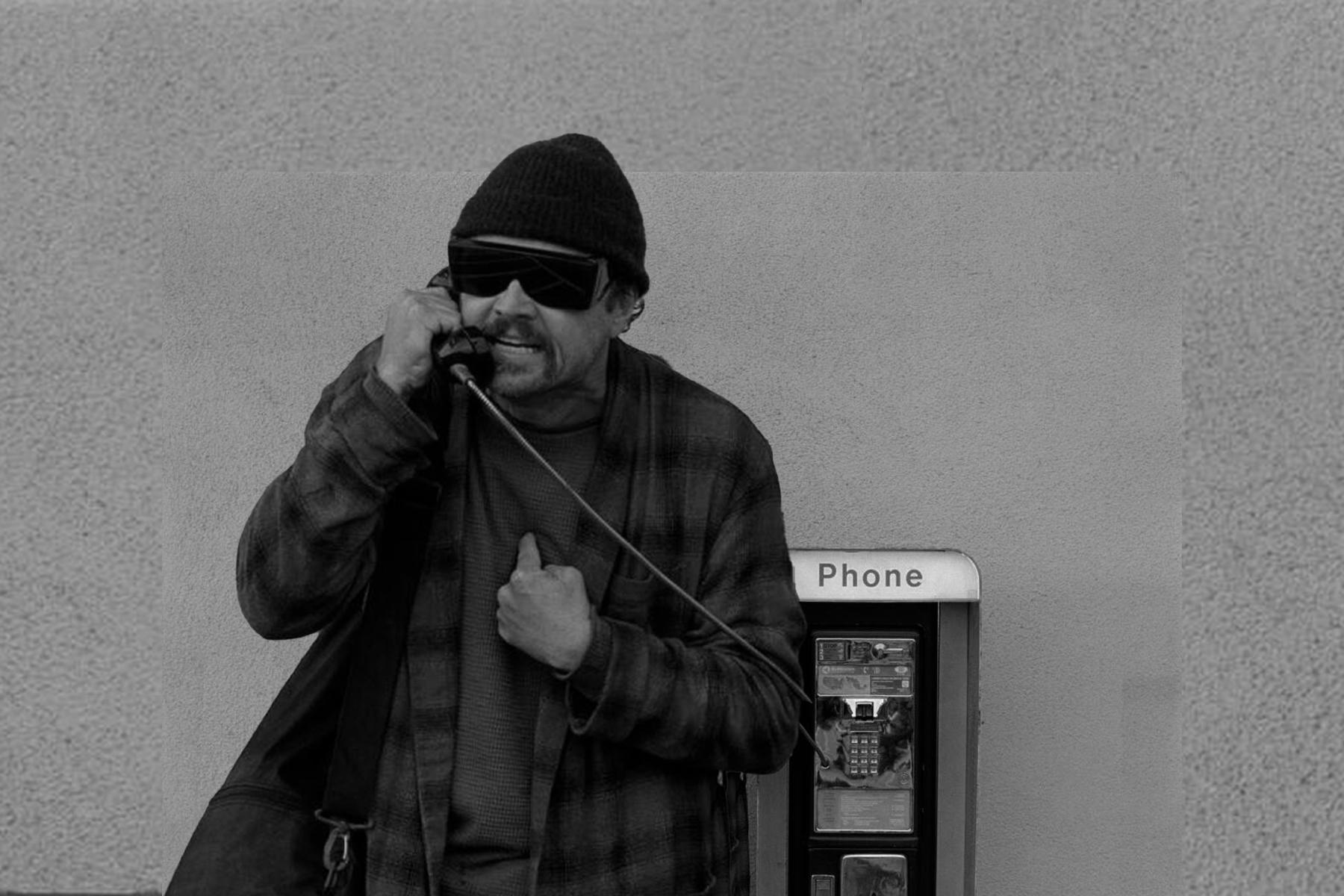
which has evolved into a hyper-militaristic authoritarian state hellbent on closing the border and hunting migrants. Running with the French 75 are couple Bob (Leonardo DiCaprio) and Perfidia (Teyana Taylor). The film begins with their revolutionary salad days, blowing up stuff and freeing migrants from detention centers. They frequently cross paths with their nemesis, Colonel Steven Lockjaw (Sean Penn), who develops a perverse sexual obsession with Perfidia. He eventually catches the two of them, forcing them to scatter to the wind. Bob and their daughter Willia (Chase Infiniti) assume new identities while Perfidia goes into witness protection. The film then jumps 16 years later. Bob has become a washed-up stoner
whose revolutionary spirit has been broken. However, when Lockjaw reemerges into his life and captures his teenage daughter, he must rejoin the fight and save his family.
The world PTA has crafted is tactile and pressing. He imagines a future where the influx of migrants from Latin America broke the brains of white supremacists who then plunged our government into a fascist regime … crazy, right? The country is tattered, with people packed like sardines in the shadows and warring against each other. The social fabric has been ripped apart as paranoia becomes the norm. Yet PTA navigates the biting political commentary with a sense of silliness; there’s a secret white nationalist cult controlling the government, but they’re called
the Christmas Adventurers. It makes for an exhilarating and hilarious odyssey through America. This thing never relents, as PTA jumps between bank robberies, sanctuary city raids and desert car chases. He films everything with ingenuity and verve, reminding you what a true visionary looks like behind the camera.
Surviving this political calamity almost requires one to be perpetually stoned like Bob. He’s resigned himself to a life of bong rips and Turner Classic Movies; it’s kind of pathetic but also understandable. Yet watching him become reinvigorated by the quest to save his daughter is inspiring to watch. Beyond all the political wrapping, the heart of the movie is the father-daughter relationship between Bob and Willa.
‘Vie’: Doja Cat goes retro
By Sydney Nelson Scene Writer
The music industry’s biggest troll is back, but she was NOT joking around with this new album. Doja Cat released her highly-anticipated fifth studio album, “Vie,” on Friday, and it has all the makings of a hit pop record. The French word “vie,” which directly translates to “life,” is a perfect descriptor for this upbeat and fun retro-inspired work.
Doja Cat first rose to mainstream fame during the 2020 pandemic era with her single “Say So,” which was a hit on TikTok. Since then, she’s released chart-topper after chart-topper, and her artistry has evolved into its own unique sound. Doja Cat has also established herself as an eccentric character with an absurd sense of humor. Whether she’s dressing head to toe in red body paint at the
Met Gala or posting nonsensical content on social media, Doja Cat has definitely showcased her true personality. Love her or hate her, her status as an icon is undeniable.
“Vie” comes nearly two years after Doja Cat released her last album, “Scarlet,” which garnered mixed reviews from the public. In “Scarlet,” Doja Cat shifted away from her usual pop-centered sound, creating a project more focused on rap and hip-hop. However, in “Vie,” she gravitates back towards pop, proving that “Scarlet” was just a little detour. With “Vie,” Doja Cat becomes the next artist to create an ‘80sinspired pop record, blending retro elements with her signature pop rap style. “Vie” is centered around her romantic life and features a multitude of iconic lyrics that express the artist’s unbothered queen energy.
The album’s lead single,
“Jealous Type,” was released in late August and served as a good preview for the album as a whole. With an upbeat tempo and catchy chorus, “Jealous Type” has all the ingredients of a pop hit. However, surprisingly, this track failed to gain the same level of attention as Doja Cat’s previous lead singles, like “Kiss Me More” from “Planet Her” and “Paint the Town Red” from “Scarlet.” But, still, I greatly enjoyed “Jealous Type” and was excited to hear the rest of the album.
When I hit play on the album’s first track, “Cards,” I was immediately enticed by the saxophone solo in the song’s intro. “Cards,” while still fairly upbeat, is one of the more steady songs on the album and is perfect for easy listening. The track starts off as more of a pop song, but towards the end, more rap elements are integrated. In this song, Doja Cat warns
It’s about the guilt of having to watch your child inherit a messed-up world you couldn’t fix, and doing whatever it takes to protect them from it. And DiCaprio absolutely kills it as a doting weed dad. He gets to really flex his comedic chops as he stumbles through all kinds of absurd situations while spewing high rants about leftist language policing. But he always remains endearing and weirdly heroic despite his incompetence; he’s just a really passionate girl dad.
Yet it’s Penn who steals the show as Lockjaw. I haven’t seen a performance this physically dialed in since Emma Stone in “Poor Things.” Every little facial tick and goofy waltz is so precise and entertaining. He’s a cartoonish, sinister buffoon, and watching the psychosexual drama of his dueling fetish for black women and white nationalist ideology is riveting. Rounding out the cast is a starmaking debut from Infiniti as Willa and a fierce, enigmatic performance from Taylor as Perfidia. Everyone plays their role in a large tapestry that sings.
“One Battle After Another” is nothing short of a miracle. I can’t believe a movie this daring was given the scale and resources to truly shine. It’s one of PTA’s finest works and stands as one of the only movies in recent memory to meaningfully grapple with the current state of this country. It’s a rallying cry that we must never stop fighting for the people we love, no matter how bleak things get.
Contact Luke Foley at lfoley2@nd.edu
her lover to be careful, telling them that they “gotta just play [their] cards.” Overall, this song perfectly sets the tone for the rest of this album.
My personal favorite song on this album is “Take Me Dancing,” featuring SZA. As a die-hard SZA fan, I may be a little biased; however, this song is bound to be a huge success. The entire song, not just the chorus, is extremely catchy, and I haven’t been able to get it out of my head.
SZA and Doja Cat have previously collaborated on the song “Kiss Me More,” which was a huge success, and “Take Me Dancing” is likely going to follow in its footsteps.
The album as a whole, which features 15 ‘80s-inspired tracks, is cohesive, with each track effortlessly flowing into the next. A downside to this, however, is that it can get a little repetitive when listening to the whole album in one sitting. But at the end of
the day, I can appreciate the overarching theme of love and pain accompanied by an ‘80sesque backtrack and vibe. In the past few years, we have seen the revival of pop music and a new generation of pop stars. “Vie” can function as a mainstream pop album, but Doja Cat’s own personal style as an artist sets it apart from other records being released. With this album, Doja Cat, without a doubt, has cemented herself as a pop queen in my eyes. However, I’m genuinely not sure how much attention this album is going to get, with its release being sandwiched between Sabrina Carpenter’s “Man’s Best Friend” and Taylor Swift’s “The Life of a Showgirl.” Nonetheless, “Vie” is worthy of being a success, and allowing it to be looked over would be a big mistake.
Contact Sydney Nelson at snelson01@saintmarys.edu
New Irish era begins with questions and promise
By Ellie Collins Sports Writer
A legendary era of Notre Dame hockey came to a close last spring when Jeff Jackson stood behind the Irish bench for one final game, ending his 20 years as head coach. Jackson took control of the Irish in the 2005-06 season and has since brought the program to 12 of their 13 NCAA tournament appearances, including four Frozen Fours and two national championship games. Though in no way tainting
the impact Jackson had on Notre Dame hockey, his closing few seasons were tough for the Blue and Gold, going 12-25-1 in 202425 and 15-19-2 in 2023-24.
One of his previous players, Brock Sheahan, who skated for the Irish from 2004 to 2008 and returned as associate head coach in 2023, officially took the helm in March following Jackson’s retirement.
Sheahan’s previous head coaching jobs were for the United States Hockey League’s Chicago Steel
from 2019-2022, during which he brought the team to their winningest season and a league championship in 2021, and the American Hockey League’s Chicago Wolves in 2022-23, which, under his guidance, earned a 35-29-5 regular-season record.
In his introductory press conference on April 9, Sheahan announced a focus on offensive capability and speed, saying it was a strong point of his previous teams and something to hone this year for the Irish. And, while
the team would be young and inexperienced, Sheahan believed the talent on hand could reestablish Notre Dame hockey’s tradition of excellence, emphasizing that this season is not a rebuilding period. “We have way more talent than people think in our locker room,” he stated. In discussing the current coaching staff and returning players, he later added, “I feel like we’re well-positioned to adapt.”
As Notre Dame starts anew this season, the entirety of college hockey will
undergo transformation. In conjunction with the NIL era, a recent rule change now permits players who have previously skated for one of the top Canadian junior leagues (Quebec Maritimes Junior Hockey League, Ontario Hockey League (OHL) and Western Hockey League) to play in the NCAA. While it is uncertain how teams will adjust to the looming changes, the influx of talent will certainly be glaring.
see “Hockey” on page 11
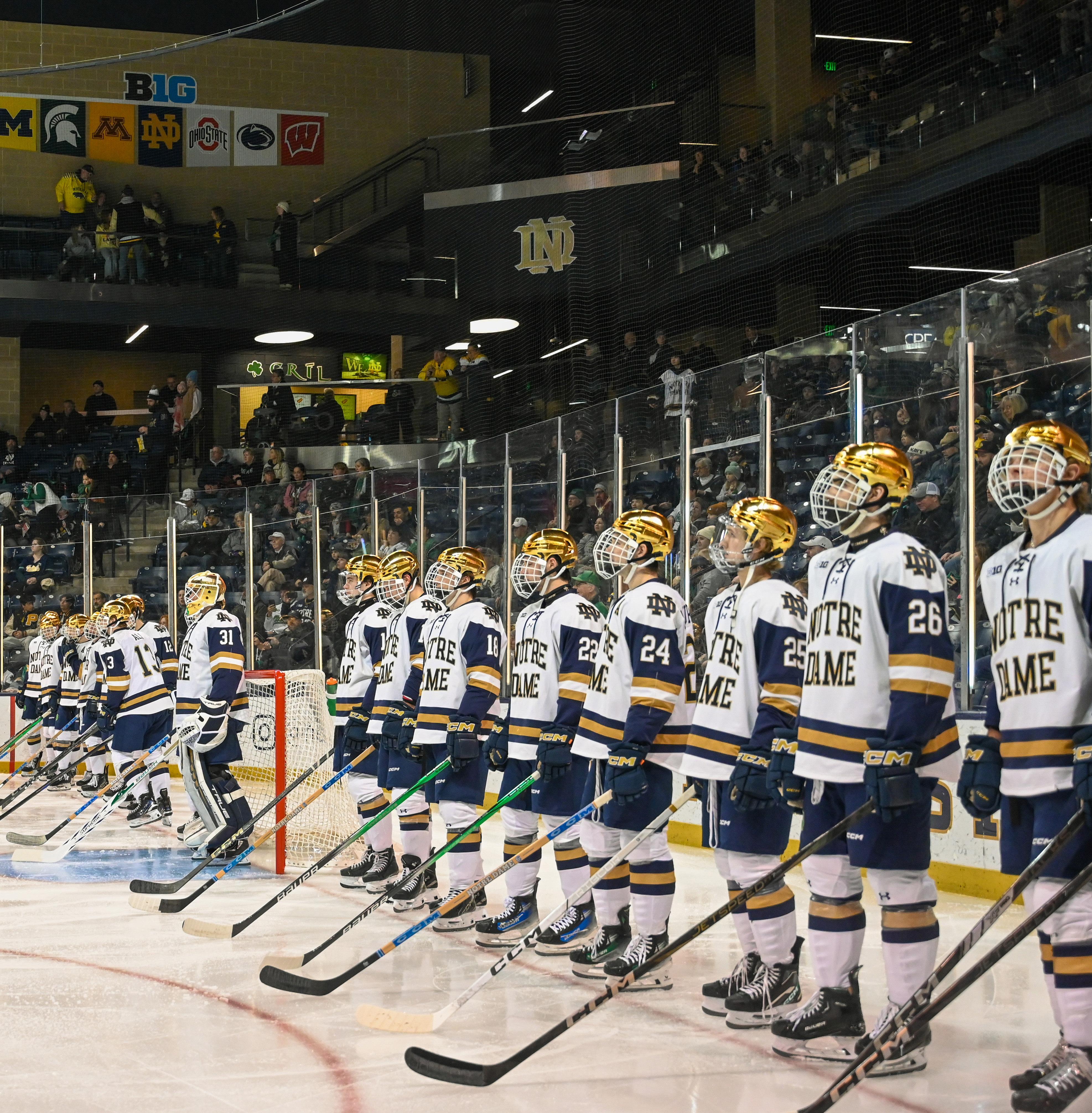
QUESTION OF THE DAY:
What was your first job, and how old were you?
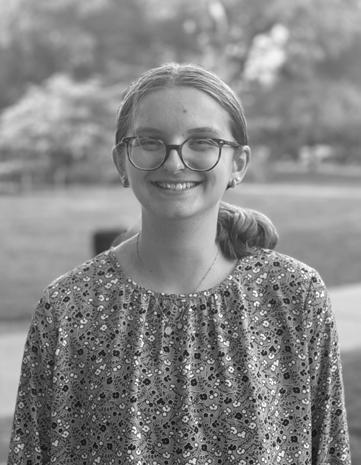
Joan Reimer junior Johnson Family Hall
“Pool snack bar at 15.”
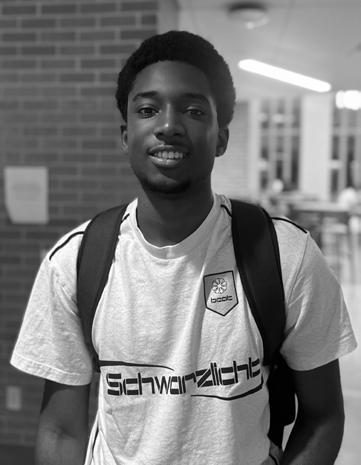
Charles N’Guessan junior Dunne Hall
“Library assistant at 16.”
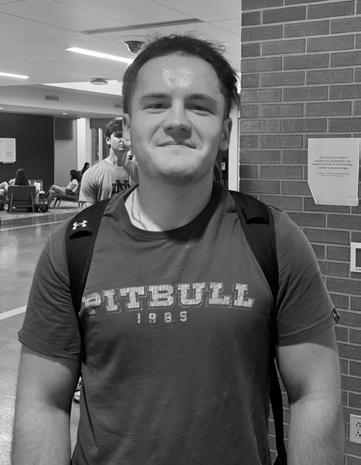
David Marek junior Dunne Hall
“Manufacturing at 15.”
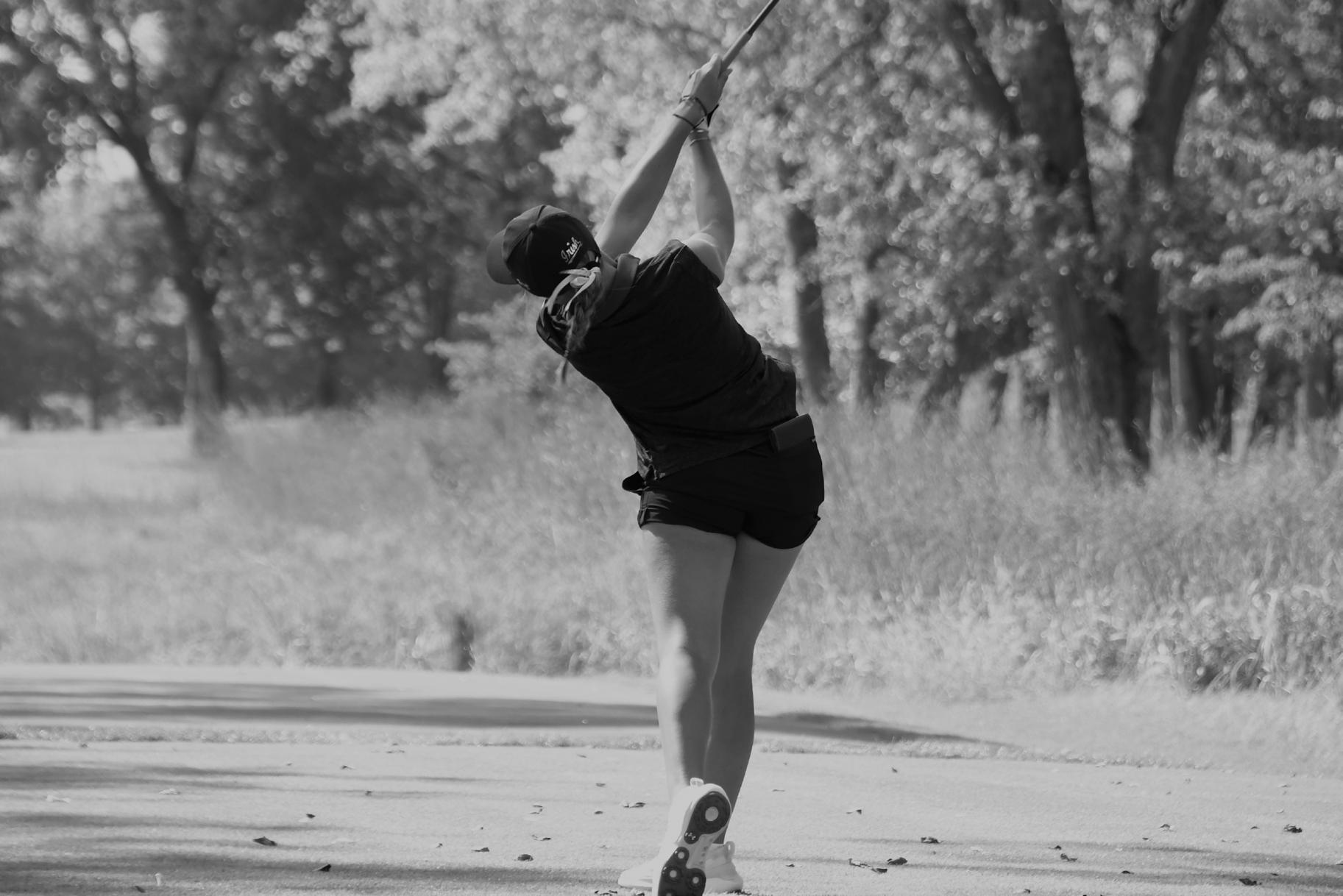
CROSSWORD | WILL SHORTZ
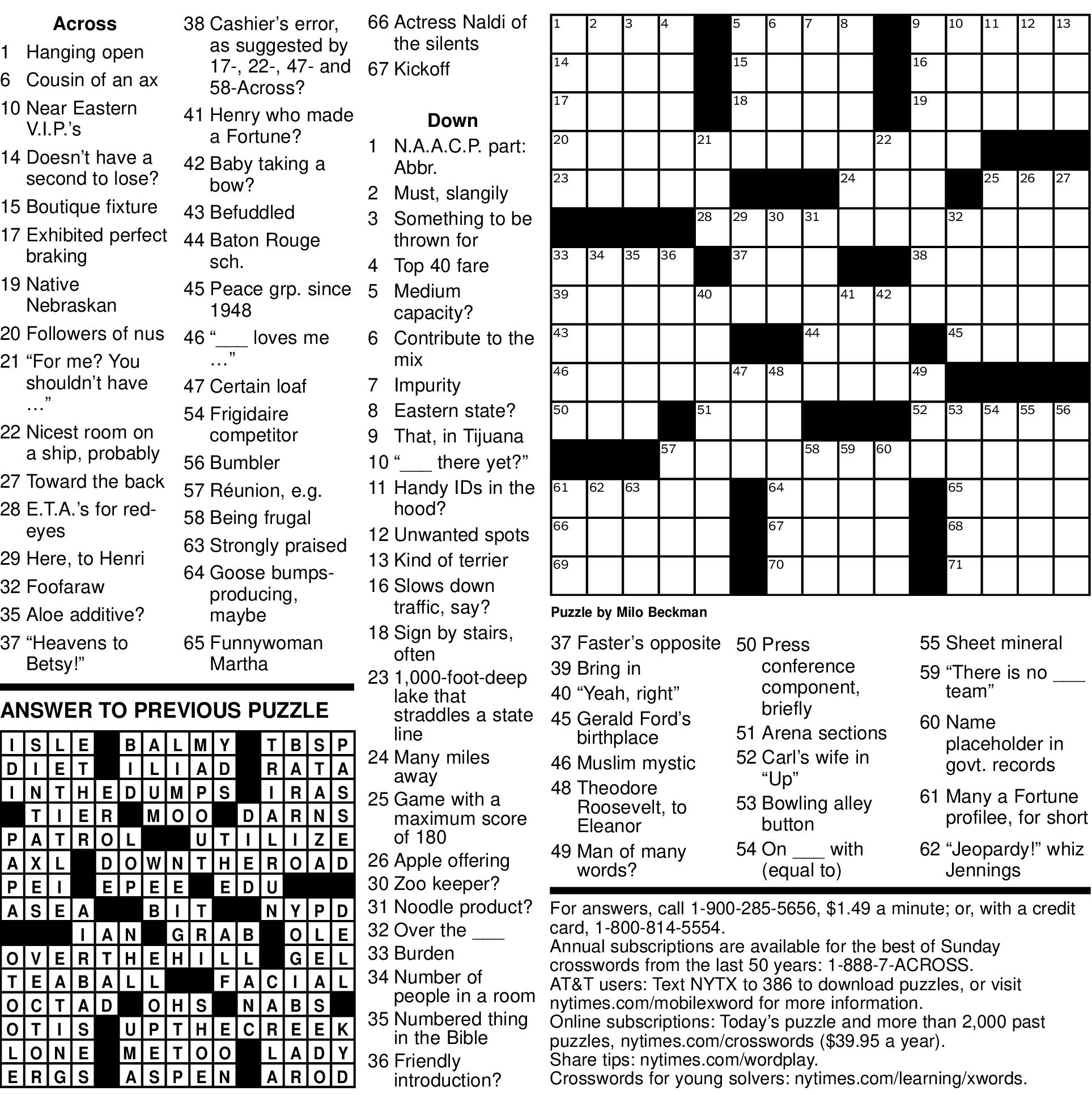
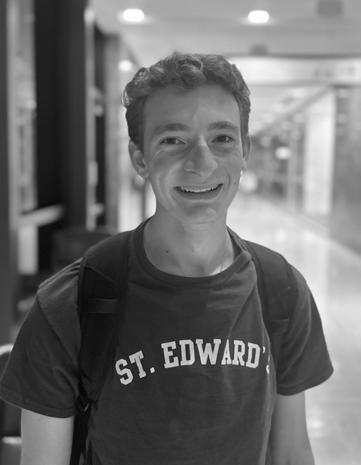
Stephen DiFranco senior St. Edward’s Hall
“Dishwasher at 17.”
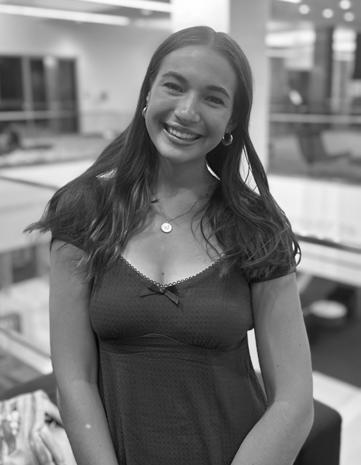
Anna Hale junior Breen-Phillips Hall
“Landscaping at 14.”
SOCIAL MEDIA POLL
Have an idea for a poll? Email dstangel@nd.edu
Do you want to study abroad?
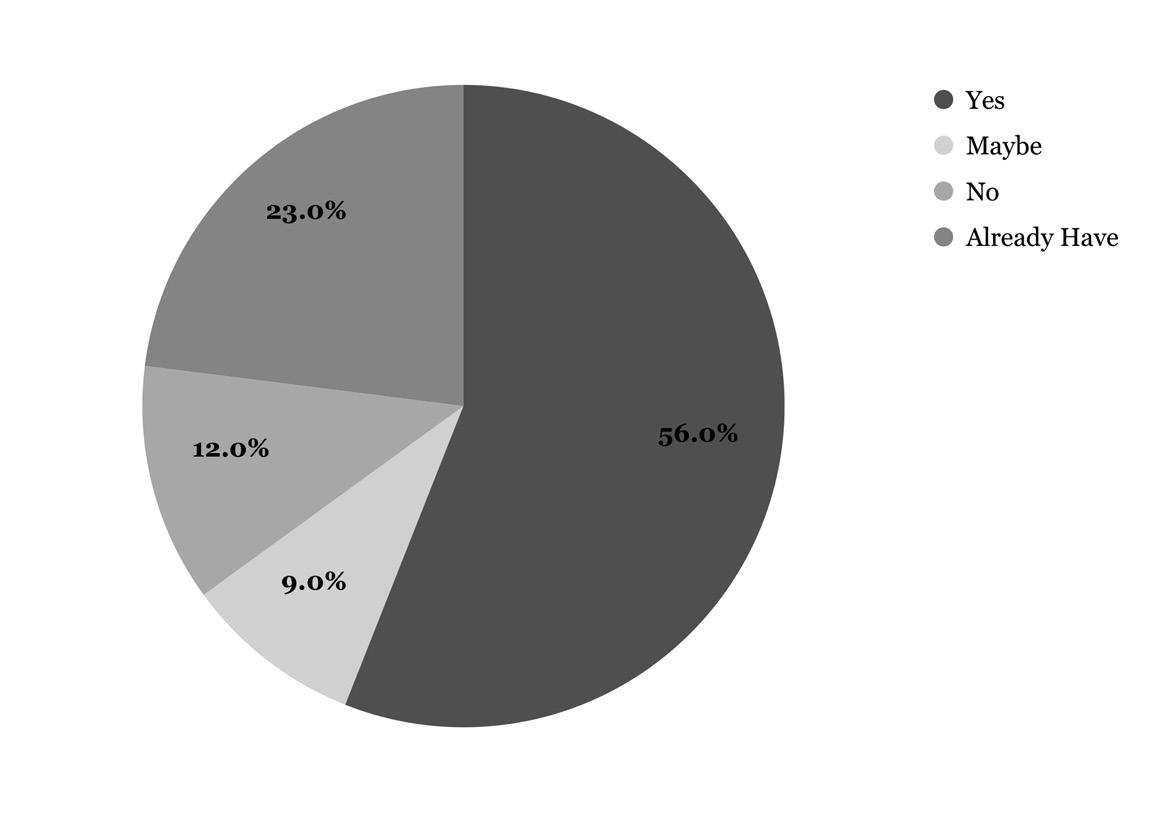
A recent poll conducted by The Observer via Instagram asked students if they wanted to study abroad; Notre Dame reports 87.5% of students choose to do so during their undergraduate years. Respondents to The Observer’s survey showed similar levels of enthusiasm for venturing beyond South Bend: 56% of respondents said “yes,” 23% said they “already have,” 12% responded “no” and an indecisive 9% selected “maybe.” Perhaps they’ll be persuaded to trade Indiana for Portugal when the first frigid December snowstorm hits campus.
THE NEXT FIVE DAYS
Want your event included here? Email news@ndsmcobserver.com
Wednesday
‘Philbin & Phriendz’ FTT will showcase songs, documentaries and performances. DeBartolo Performing Arts Center 7:30 p.m.
Thursday
Zombie Preparedness Festival
Recieve safety information with a zombie-themed twist. Outside of Notre Dame Stadium, Gate E 11 a.m. - 2 p.m.
Friday
Notre Dame Symphony Orchestra Concert
The orchestra will play excerpts from “Romeo and Juliet.” DeBartolo Performing Arts Center 8 p.m. - 9:30 p.m.
Saturday
Notre Dame football vs. Boise State
The Fighting Irish take on the Broncos. Notre Dame Stadium 3:30 p.m.
Sunday
Film and Panel Discussion: ‘Nosferatu’ (2024) American gothic horror film inspired by novel “Dracula.” DeBartolo Performing Arts Center
7 p.m. to 9:15 p.m.
Irish pick up first victory of the Breanna Jenco era
By Chris Dailey Sports Writer
The Notre Dame women’s golf team successfully defended their home turf this weekend by capturing first place at the Women’s Fighting Irish Classic. Notre Dame shot seven over par through the two-round tournament, a staggering 24 shots clear of second-place Youngstown State. The Irish had three golfers finish in the top four, with junior Alexsandra Lapple taking the cake by shooting an impressive 141 (-3).
Lapple’s victory was kickstarted by a brilliant display of golf during round one. After finishing with bogey on a hard par-five second hole, Lapple exploded. She recorded one birdie to bring herself back to even by the end of the front nine. She then notched three consecutive birdies through holes 11-13 and one more on hole 17 to finish with a 68 (-4).
Although Lapple logged four bogeys during round two after an initial early birdie, she stormed back with birdies on holes 17 and 18 to finish the round with a top-drawer 73 (+1).
Lapple’s first-place performance was closely followed by freshman Jordan Levitt. A 2025 U.S. women’s amateur qualifier, Levitt has soared since arriving in South Bend. She shot 73 (+1) during round one behind three birdies, but caught fire in round two. Levitt sank five birdies en route to a 70 (-2) finish, bringing her overall score to one under par.
Sophomore Maddy Bante placed fourth. Bante’s fantastic performance in round two, shooting one above par, brought her into the top of the pack. Bante’s fourth-place finish is the highest of her career, having finished fifth overall
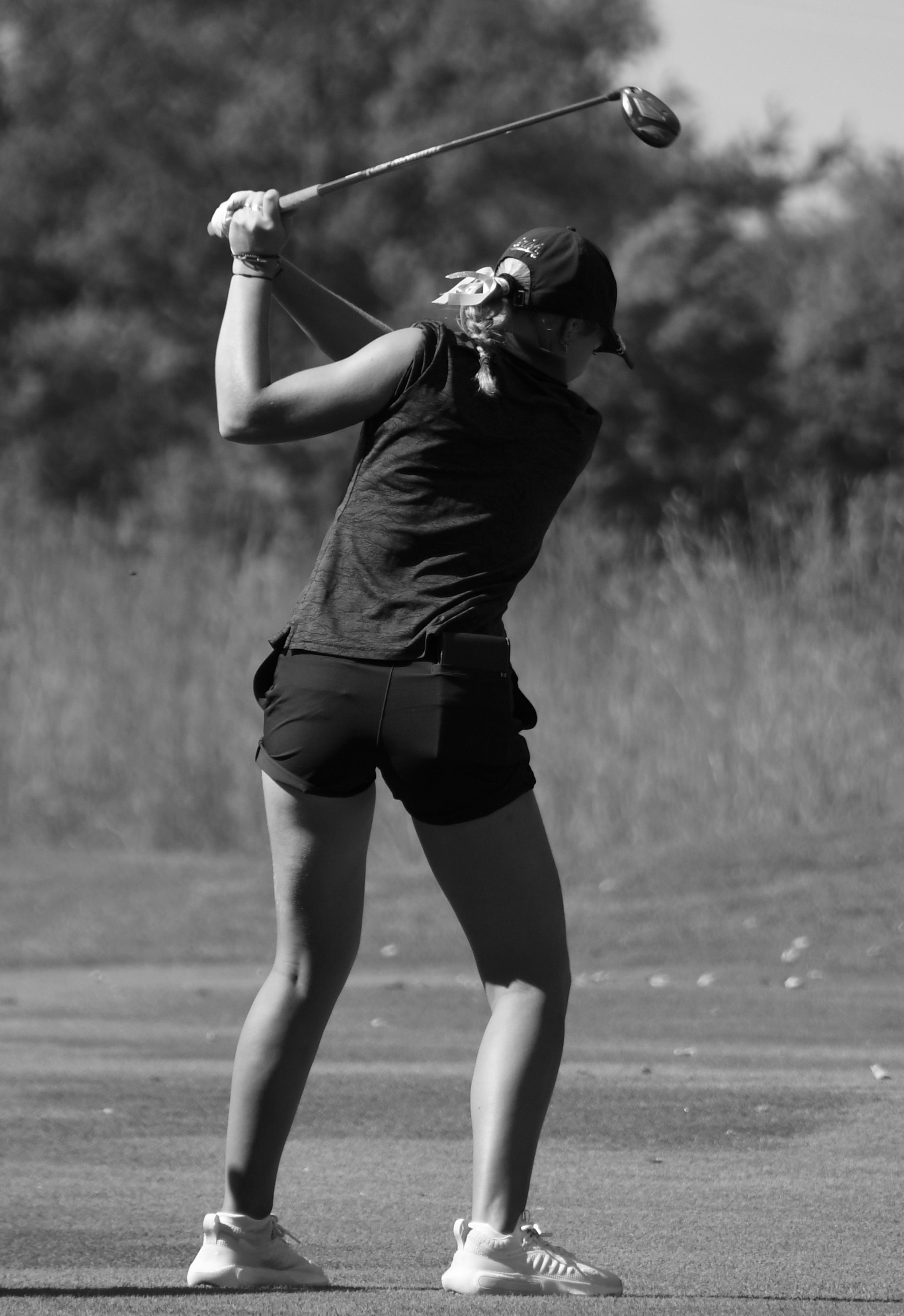
twice as a freshman. Bante also averaged 74.2 strokes a year ago. As she finds form in and around the greens, she has potential to be a gamechanger for the Irish.
Sandwiched in between Levitt and Bante’s second and fourth-place finishes was Youngstown State senior Maddi Shoults. Shoults delivered an even performance in round two to leapfrog much of the individual table.
Freshman Sawyer Brockstedt finished fourth for the Irish in team competition, placing 11th overall. Brockstedt shot 155 (+11) through 18 holes. A big-time addition for Notre Dame, Brockstedt finished top10 at 15 American Junior Golf Association tournaments.
Sophomores Faustine Errecade and Caroline Owens competed as individuals, as well as freshman Taryn Cagle. Errecade displayed the best form, shooting 154 (+10) with a total of four birdies. Her showing earned her a 10th-place finish.
Owens and Cagle finished 24th and 29th, respectively. Owens shot 160 (+16) while Cagle trailed not too far behind with 162 (+18).
The win marks Notre Dame’s first in the Breanna Jenco era. Taking over the head coaching role from Caroline Powers Ellis, Jenco is a proven winner. Her track record at Xavier suggests that there is a lot more winning to be done.
Notre Dame can do just that as they head to the Sunflower Invitational hosted by Kansas on the weekend of Oct. 6. They wrap up their fall season in late October with invitationals at Texas State and UNC-Wilmington.
Contact Chris Dailey at cdailey2@nd.edu
Belles golf finishes 11th at Bulldog Fall Classic
By Harrison Brown Sports Writer
This past weekend, Ferris State University hosted the annual Bulldog Fall Classic in Big Rapids, Michigan. Saint Mary’s was one of 13 teams competing in the event. The Belles were in for a challenge, as the lone NCAA Division III program at the classic, competing among some of the premier Division II teams in the region. Over the two rounds of the weekend, Saint Mary’s finished +84 and in 11th place on the team leaderboard.
So far this season, sophomore Melanie Maier has been the top performer for the Belles, a trend that would
continue this weekend. Maier was extremely proficient on the back nine, carding a 37 through the stretch in both rounds on the back. After the first 18, Maier sat at 81 strokes; a second-round performance of 76 allowed her to climb 13 spots in the rankings. In total, Maier carded a 157 in the event, a score that gave her a top-21 finish on the individual leaderboards.
Colleen Hand had the second-best overall score for the Belles. The junior shot a team-best of 80 in round one and followed it up with an 81 in the following round.
Her final tally of +17 left her tied for 35th. Hand sank two
birdies in the event, one of three Belles to reach that mark.
Seniors Amanda Melling and Breana Harrington would round out Saint Mary’s scorecard in both rounds. In round one, Melling sank two birdies, which fueled a score of 85. The next day, Melling found one more birdie and finished with an 82. For Harrington, round one saw her match her teammate, also carding an 85. In the second round, she added 90 more strokes to her score. In the end, Melling took a 60th-place finish, and Harrington took a top-67 finish.
The Belles also saw Ella
Notaro play the first round of her sophomore season this weekend. In her freshman season, Notaro competed in four rounds with a low score of 87. In the first round of her season this year, she broke her career low, shooting an 86. Saint Mary’s final golfer was Katharine Swain, who competed as an individual in the event, and finished 76th. The classic was the fourth event Swain has competed in.
The Grand Valley State Lakers dominated the event and took first place. The top three individual performances all belonged to the Lakers, including that of sophomore Lea Stotz, who claimed her
first collegiate golf victory. Stotz carded a 70 in both rounds of the event to end with a score of -4. By the end of the weekend, Grand Valley State found itself at the top of the leaderboards and 20 strokes in front of second place.
Saint Mary’s only had a few days of rest before their next event. Following the Bulldog Fall Classic, the Belles resumed conference play Tuesday, Sept. 30 in the second Michigan Intercollegiate Athletic Assocation Jamboree.
Contact Harrison Brown at hbrown23@nd.edu
Hockey
Continued from page 8
Most notably, freshman forwards Cayden Lindstrom and Porter Martone, two early first-round picks in the 2024 and 2025 NHL Entry Drafts, will be playing for Michigan State University, and freshman forward Gavin McKenna, the expected No. 1 pick for the 2026 Draft, will skate for Penn State University.
Three Irish freshmen are coming in from the OHL — forwards Cole Brown and Pano Fimis and defenseman Caeden Carlisle, each with strong credentials. Notably, Brown was a sixth-round pick in the 2023 draft, and Fimis was a two-time nominee for most outstanding player in the OHL. Additionally, last Thursday, 17-year-old OHL forward Beckham Edwards, a top 2026 Draft prospect, announced his commitment to Notre Dame. Though he will not be seen wearing blue and gold until 2027, Sheahan has made his presence known in recruitment and has made clear his ability to adapt to the NIL landscape.
Moreover, if Notre Dame is to return to form this season, it must start with
better defense, after giving up the most shots in the nation last year. The goaltending is expected to be solid behind Nicholas Kempf, a highly touted sophomore, and Yale graduate transfer Luke Pearson. Kempf shared duties with Owen Say last year (who departed for the Calgary Flames) and flashed the talent that made him a fourth-round pick in the 2024 Draft. The second-year netminder, known for his high-level athleticism and sound technique, provides the foundation necessary for a defensive turnaround.
However, in the wake of the Irish surrendering a Big Ten high of 3.34 goals per game last year, despite solid play in the net, the backline needs to provide improved support. Senior defensemen Michael Mastrodomenico (a captain) and Axel Kumlin spearhead the unit, and juniors Paul Fischer and Henry Nelson both look to build on promising sophomore seasons. Fischer, a fifth-round pick in 2023 and preseason All-Big Ten Second Team selection, led the Irish in blocks with 61 and provided some offensive punch with 19 assists last season. Nelson chipped in with 40 blocks. Sophomores Jimmy
Jurcev and Jaedon Kerr, who both earned time last year, and newcomers Carlisle and Drew Mackie round out the corps.
The young Irish offense will need to find its footing in the early days of the season. Of last year’s 288 points, 38% were earned by non-returning players, most notably, forwards Justin Janicke and Blake Biondi, who averaged the second and thirdhighest points per game with 0.89 and 0.71, respectively. The Irish’s scoring offense ranked No. 39 in 2024-25, with 2.68 points per game. Though less experienced on college ice, as Sheahan asserted, this season’s team has the talent needed to establish a vastly improved offensive power, an area in which the Irish have lacked in recent history.
Junior forwards Cole Knuble, who led the team in points and assists his sophomore season with 39 and 27, respectively, and Danny Nelson (a captain), who added 26 and 13, respectively, will return as the cornerstones of the Irish offense. With his performance in the preseason, Knuble was selected for the preseason All-Big Ten First Team after being 2024’s only all-conference honoree
for the Irish. Junior Carter Slaggert will back him and Nelson following an impressive display last season with 10 points. The hometown product also offers defensive help, accumulating 20 blocks last year.
In addition to the two OHL forwards and freshmen Will Belle, Charlie Pardue and Dashel Oliver, two highly regarded transfers will join the roster. Junior Evan Werner is coming from the University of Michigan, where he amassed 11 goals and 11 assists, the third most points earned by a Wolverine last season. Graduate student Sutter Muzzatti also enters with good credentials from Rensselaer Polytechnic Institute; he had a promising freshman year, followed by injury-riddled seasons. Notre Dame will need both the returning forwards to further develop and the highly regarded new faces to produce in order to succeed in a challenging schedule.
The Irish are set to officially kick off their season on Oct. 10 with a matchup against Arizona State, before beginning the home slate on Oct. 16 against St. Lawrence. Starting in week three, their schedule
CONQUERING THE ULTIMATE DISEASE INSTIGATOR Reversing the Aging Process
Friday, October 3, 2025
3:30pm - 4:45pm
Jordan Auditorium, Mendoza College of Business Free and open to the public. No tickets or registration required.
ABOUT SERIES
The Thomas H. Quinn Lecture series is an annual event hosted by the Mendoza College of Business and sponsored by Notre Dame alumnus and trustee John W. “Jay” Jordan II, Quinn’s college roommate, longtime friend and business partner, in his memory.
heightens to a difficulty it remains at until the end of their season, with back-toback games against No. 12 Michigan, No. 8 Minnesota and No. 3 Michigan State. In late November and early December, the Irish battle No. 2 Boston College, No. 20 Wisconsin and defending champion No. 1 Western Michigan. January will bring more heat with matchups against No. 5 Penn State and No. 16 Ohio State.
Sheahan is being thrown into the fire this first season, with little time for a learning curve. Fortunately, at his disposal, he has top-flight powers in Knuble and Nelson for the offense, Fischer for the blueline and Kempf in the crease. Given the Irish’s schedule and inexperience, a bid to this year’s tournament would nonetheless be extremely impressive; they are predicted to finish last in the Big Ten preseason coaches poll. But Sheahan affirms that Notre Dame has the promise to shine. “We’ll get better every day,” he said in his April press conference, “and that’s what you’ll see from our program [and] our players.”
Contact Ellie Collins at ecollin9@nd.edu
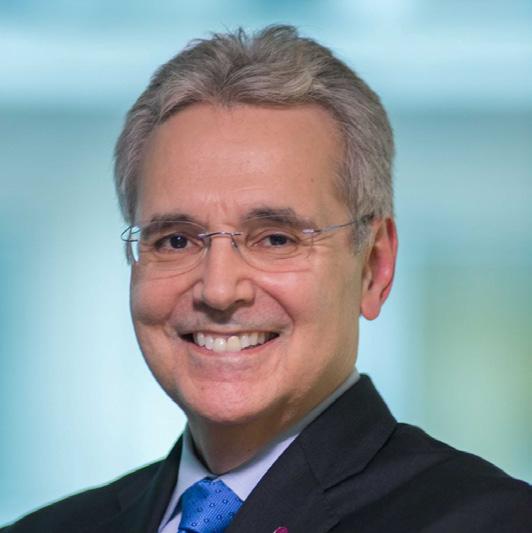
Ronald A. DePinho, M.D. Physician-scientist, serial entrepreneur and past president of MD Anderson Cancer Center
In his talk, Dr. DePinho will share insights into the forces shaping scientific research and its impact on humanity. He will then dive into the mechanisms driving aging and the transformative potential of science to extend healthspan and combat age-related diseases such as cancer and Alzheimer’s. He will provide knowledge on how to live a healthier life.
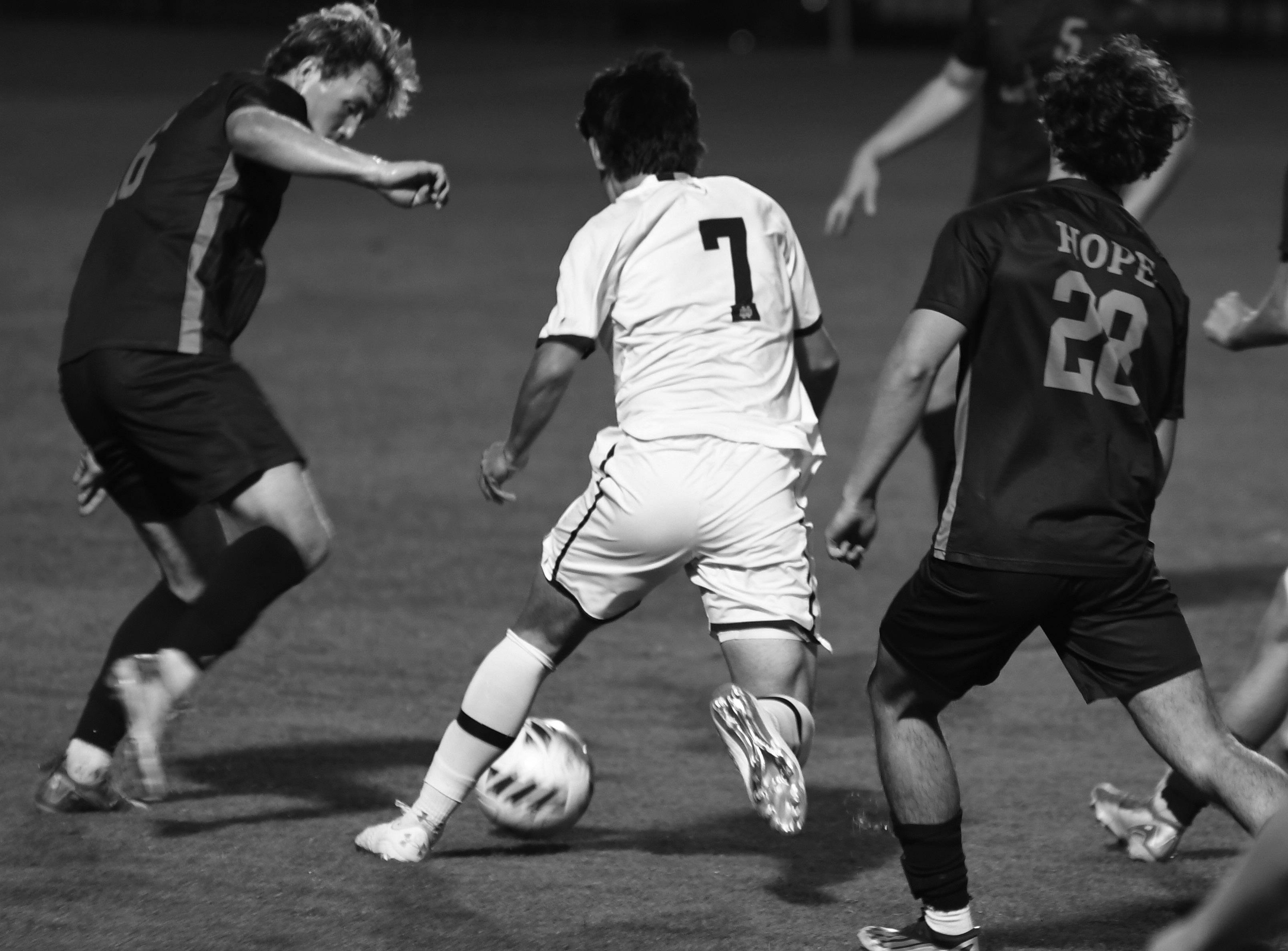
Notre Dame holds on 3-2 against Hope College
By Nikki Stachurski Sports Writer
Notre Dame men’s soccer continued their seven-game homestand against Division III opponent Hope College on Tuesday evening. Freshman defender Alex Rosin opened the scoring first for the No. 23 Irish, only to be met with a Flying Dutchmen goal shortly after by sophomore forward Jackson Mindling. The Irish led 2-1 going into the second half thanks to a goal by freshman forward Luke Burton. Soon after, Hope junior defender Michael Dietz scored, allowing the Flying Dutchmen to tie the game at 2-2. In the 83rdminute, freshman forward Ren Sylvester scored the game-winner for Notre Dame, allowing the Irish to scrape by with the win.
Last Saturday, the Irish fell short in an unexpected loss to Atlantic Coast Conference (ACC) opponent SMU at home. The Mustangs outscored the Irish 2-0, with junior forward Milton Lopez scoring both goals of the night. Despite the loss, the Irish took the weekend to recuperate and work on fundamental aspects of their success coming into Tuesday’s game against
Hope.
The Irish offense went to work right away, earning two corner kicks in the first 10 minutes.
Senior midfielder KK Baffour directed both, making brilliant deliveries to the six-yard box just in front of the net. After three phenomenal passes, freshman forward Ren Sylvester assisted on the opening goal for Rosin, who landed a shot in the bottom left of goal at the 10-minute mark. This was the first career goal for Rosin, who had two assists in the game against Omaha.
The Flying Dutchmen did not want to be counted out early and got on the board shortly thereafter. Mindling dribbled past the Irish defense to score an unassisted equalizer into the bottom left of the goal. Mindling is Hope’s top scorer, accounting for six of the team’s 25 goals coming into tonight’s match.
Both defenses had to endure an eventful first half. While Notre Dame placed an emphasis on breaking up passes and anticipating the offensive structure of Hope, the Flying Dutchmen defense utilized a physical form of play. Each team earned a yellow card in the first half, but Hope gave up six corner kicks they
could not afford against Notre Dame.
Despite corners being a weakness for this Notre Dame team so far this season, they capitalized on opportunities in the first half.
Senior defender Mitch Ferguson took the corner for Notre Dame in the 42nd-minute, making a direct pass to freshman forward Luke Burton to score a header on the left side. Burton has been making a significant impact in his first campaign, especially when working alongside classmates Rosin and Sylvester, as seen tonight.
The second half was off to a slow start, with both teams working to establish plays on offense. Hope was successful 15 minutes in, with a goal by junior defender Michael Dietz. Dietz was set up with two beautiful passes by junior defender Caden Chenlo and Mindling, beating Irish sophomore goalkeeper Blake Kelly clean on the top left side. Hope capitalized on the scattered Notre Dame defense, which had been messier and less organized than in recent games.
It was a big night for Notre Dame freshmen, with Sylvester scoring the game-winner on the left side in the 83rd-minute. The
Ann Arbor, Michigan native was assisted by junior midfielder Wyatt Lewis and sophomore midfielder Ian Shaul to give the Irish the go-ahead.
Notre Dame was able to hold onto the one-goal advantage, although the Hope offense was adamant in making a last-ditch effort to score as the clock ticked down. Although they lost, tonight’s game was a massive success for Hope College. Notre Dame is the toughest opponent they will play all season, and they were able to keep the game close despite the heavy total of fouls and yellow cards drawn throughout tonight’s match.
The Irish emerged victorious, but there were aspects of tonight’s play they will undoubtedly want to improve before their next game. Their defensive line, which has been notable this season, did not appear as synchronized and fluid as they had previously. Their communication on the pitch and camaraderie off the pitch is what makes them such a reliable unit, so the Irish will definitely want to ensure they can return to their earlier success.
The Irish offense tonight was not as structured as it has been,
especially compared to facing ACC opponents, and they cannot rely solely on improvised plays to score. Nevertheless, the Irish offense was able to pull it off once again and will hopefully have fallen back into their successful stride by Friday.
The Notre Dame freshmen have been making a massive impact on the team, and Ren Sylvester demonstrated that excellence tonight. When speaking about his class’ impact on the team, he explained, “I think we’ve been able to contribute a lot, which is great, and it’s been really good to see.” If this is just the success of these players during their first season, their talent as upperclassmen will be outstanding.
Looking ahead past tonight’s victory, Notre Dame will face Virginia Tech at Alumni Stadium Friday, Oct. 3. The Irish will have a primary opportunity to maintain their priorities on defense and work toward offensive cohesiveness, which will be crucial to racking up victories over the remainder of the ACC season.
